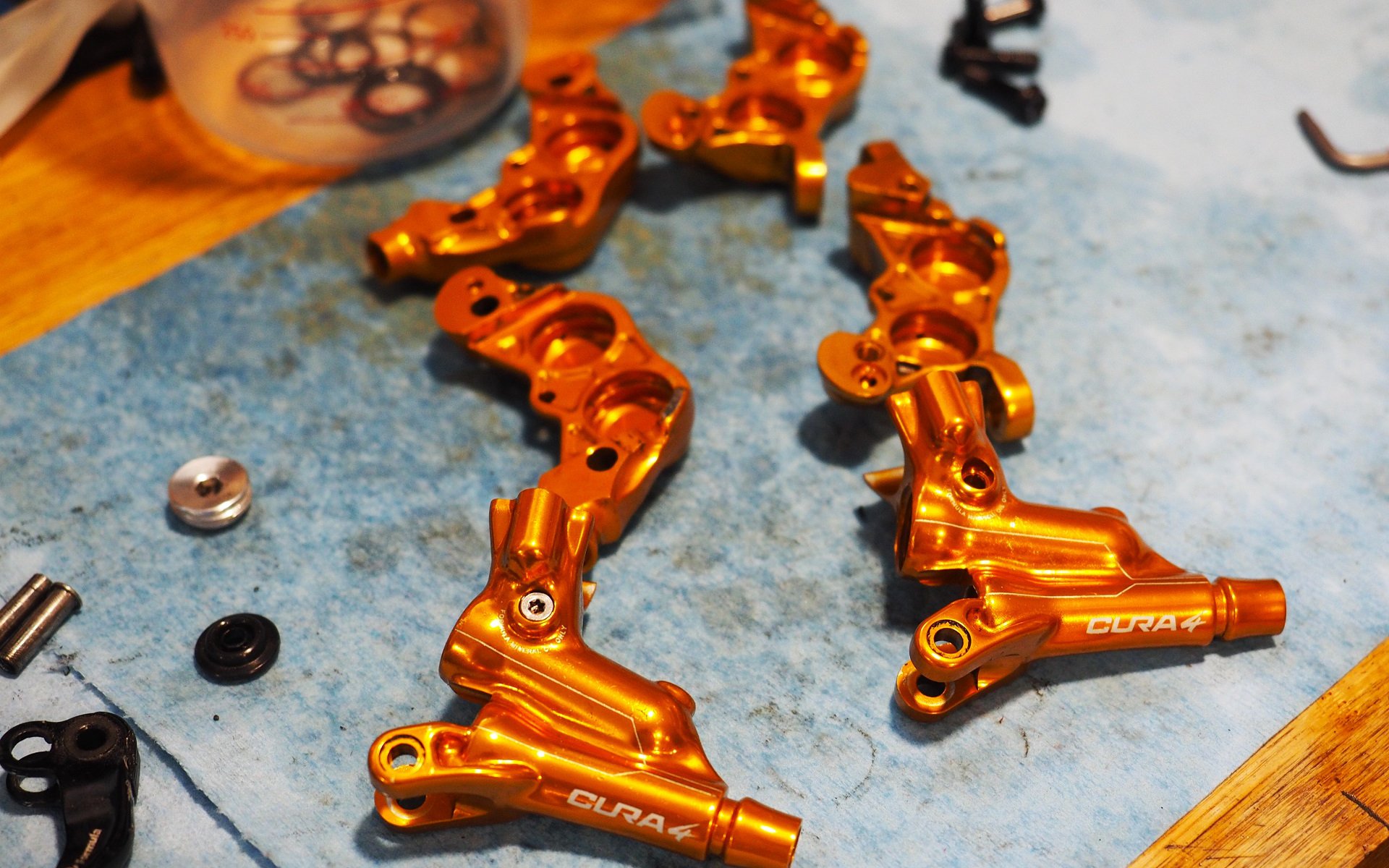
EDITORIAL | TEARDOWN
Brakes Of Future Past
Teardown Truths
I usually teardown stuff when it's fresh for a few reasons. One, it's nice to see inside a product as it is fresh from the factory. There's no hiding a lack of grease, or oil, or justifying the presence of tool marks when a product is fresh out of a box. I like to document things like a dropper post seal head that's insufficiently lubricated and then, and maybe this is a bit controversial, as I'd expect any shop to do with a product they're selling that's stiction-heavy out of the box, I like to add a bit of lubrication. It only takes a minute to properly lubricate a dropper post seal head, for example. And, while bleeding a brake or dropping some fork lowers to lubricate dry seals takes longer, I don't see why I would spend months riding a product for a review that's in a state I would never accept as a consumer. Document, fix, ride, review.
Another reason to take stuff apart when it's fresh is that it's usually easier. And in the case of these Formula Cura 4 brakes that have had over two years of consistent year round use, that was especially true. For example, brake caliper pistons are much harder to remove when the seals have been at work for a couple of years. This didn't come as any surprise; there's a reason my brakes felt like crap compared to when they were new. Regular brake bleeds, and even regular piston resets, are not a replacement for a complete teardown and re-lube. If it weren't for the fact that these Cura 4 brakes are fully serviceable I'd be looking to retire them this year. Or perhaps to rehome them with a clear explanation of the reasons they were no longer meeting my expectations.
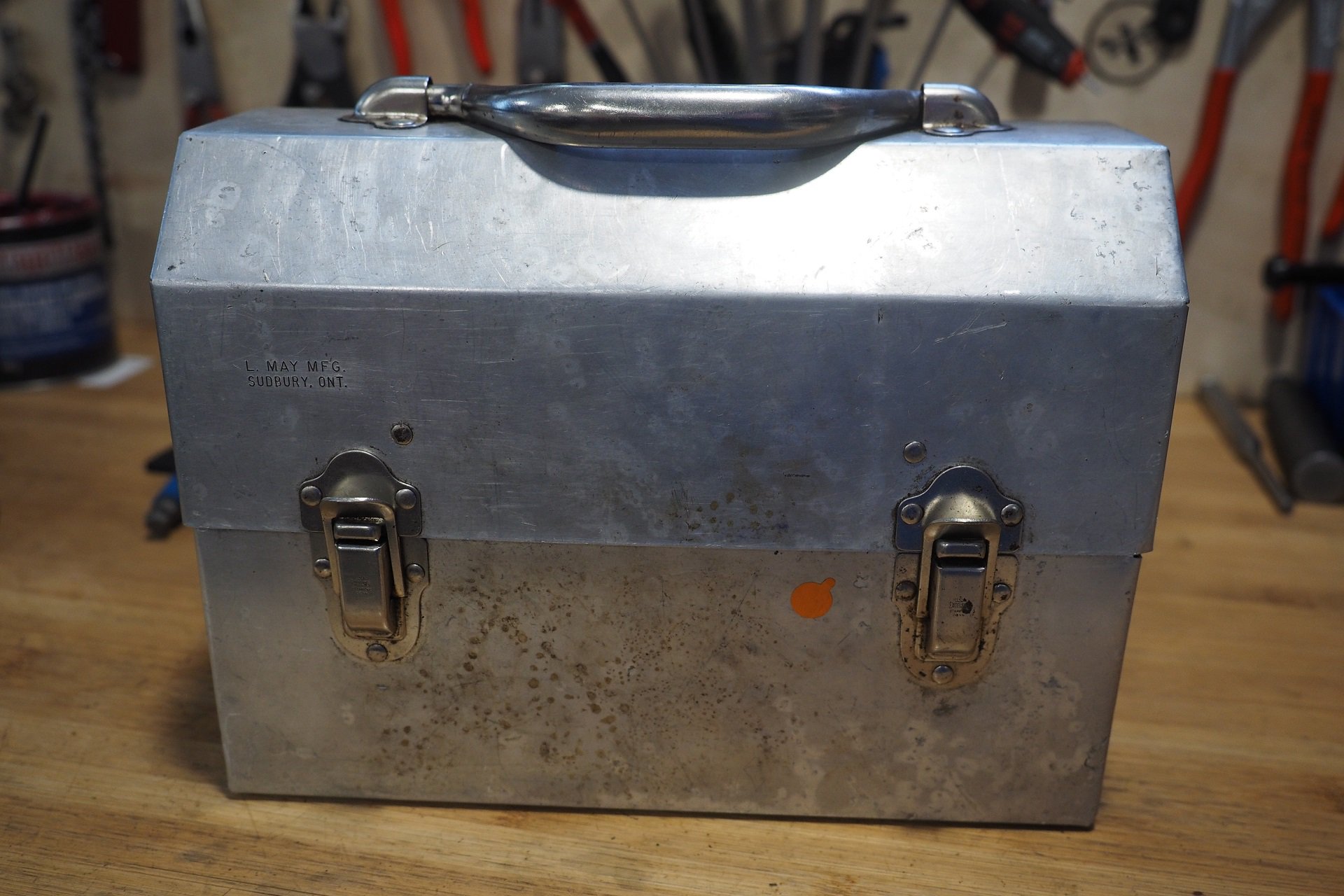
Object permanence. This has been my mineral oil bleed box since the early '00s. I keep the syringes, fluids, blocks and various other bits to do Magura, Shimano, and now Formula brakes in here. In the 1970s and '80s it was my dad's lunch box working summers in a refinery while going to school and then in mines in Northern Manitoba. In the time between it sat empty on a shelf in his shop.
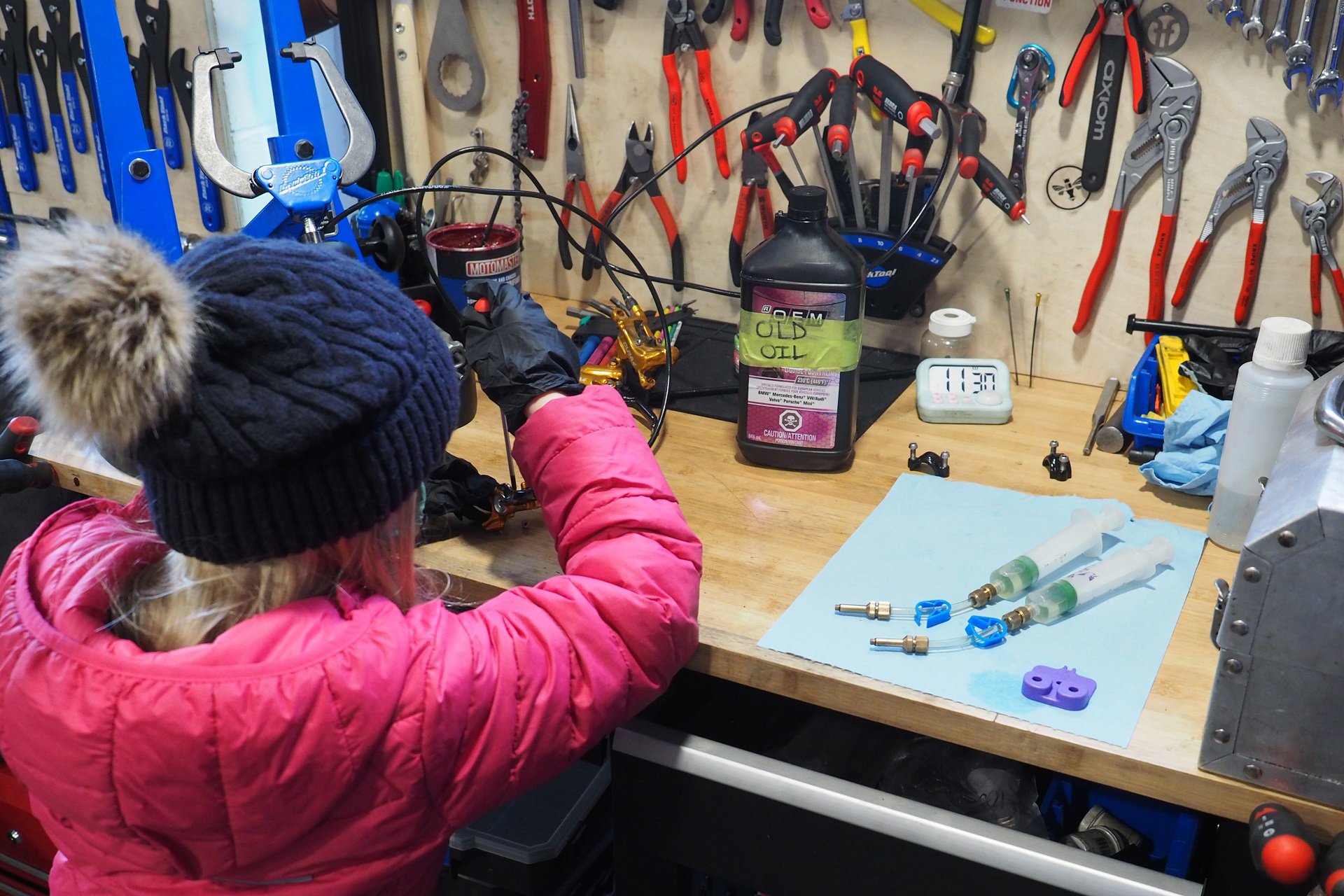
My kid took most the photos for this piece and did a bit of wrenching too. She was supposed to be in school but protestors shut down the local road system and left us stranded between buses, for the second time this year. The wind was cold and blowing and we eventually pulled the plug on transiting further and spent the day with #NiceGuyGeoff in the shop instead. Photo: AM
After we finished our RingDrive 2-Year teardown, which notably refreshed a King rear hub that I didn't think was that bad, I figured these Formula brakes would next. When Nice Guy Geoff, The Clairebarian, and I finished fully stripping them and rebuilding them they were once again ride ready. With Geoff's careful touch and experience we didn't end up needing a single replacement part. If I was tackling this job myself and concerned about downtime I'd prefer to have a couple of caliper pistons on hand - having damaged pistons before - and, as with SRAM brakes, it takes a deft hand to get the circlips out in reusable condition with any circlip pliers I've used. Formula sells all these parts in kits but they can be pricy. This preserved the value proposition of a rebuild versus new brakes.
If you're here looking for a complete Cura 4 brake teardown I'd like to sluice you over to the teardown I did with Bikeroom-Jeff in the fall of 2019. For a ride review, I put together a follow up in February 2020. Until recently, the Cura 4 was the only brake I've used on Waltworks V2. First a black pair that included the master cylinders from the Cura 2 brakes I reviewed previously and some four piston calipers I purchased.
I swapped the black ones back to being two-pistons brakes ages ago for use on my commuter/ATB and moved these gold ones over from my Marin Alpine Trail to my V2 at that time. I remember them still feeling fresh when I bled both brakes and moved them to the Walt, but clearly life has not been easy since. A couple of pistons were almost seized in the rear caliper, there's some obvious corrosion that I'll put down to the road portion of my rides in nasty winter conditions. Cosmetically, I've cleaned them up as best as I could, but I think the key here is that, but for a little bit of lever blade slop that I still need to shim out, they are working as new.
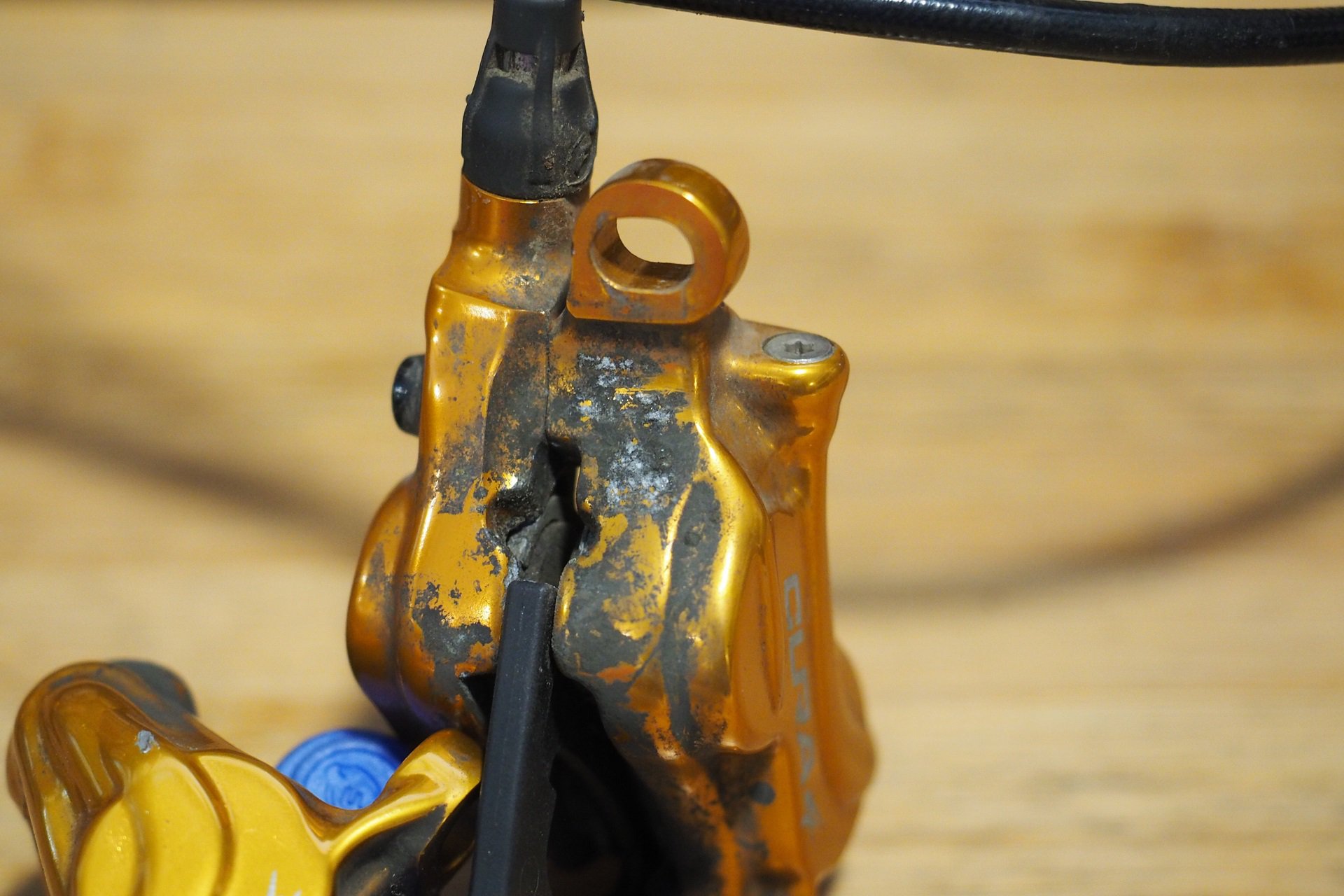
The rear brake caliper actually cleaned up very nicely from this state. Plenty of hours spent riding to my rides in different weather conditions.
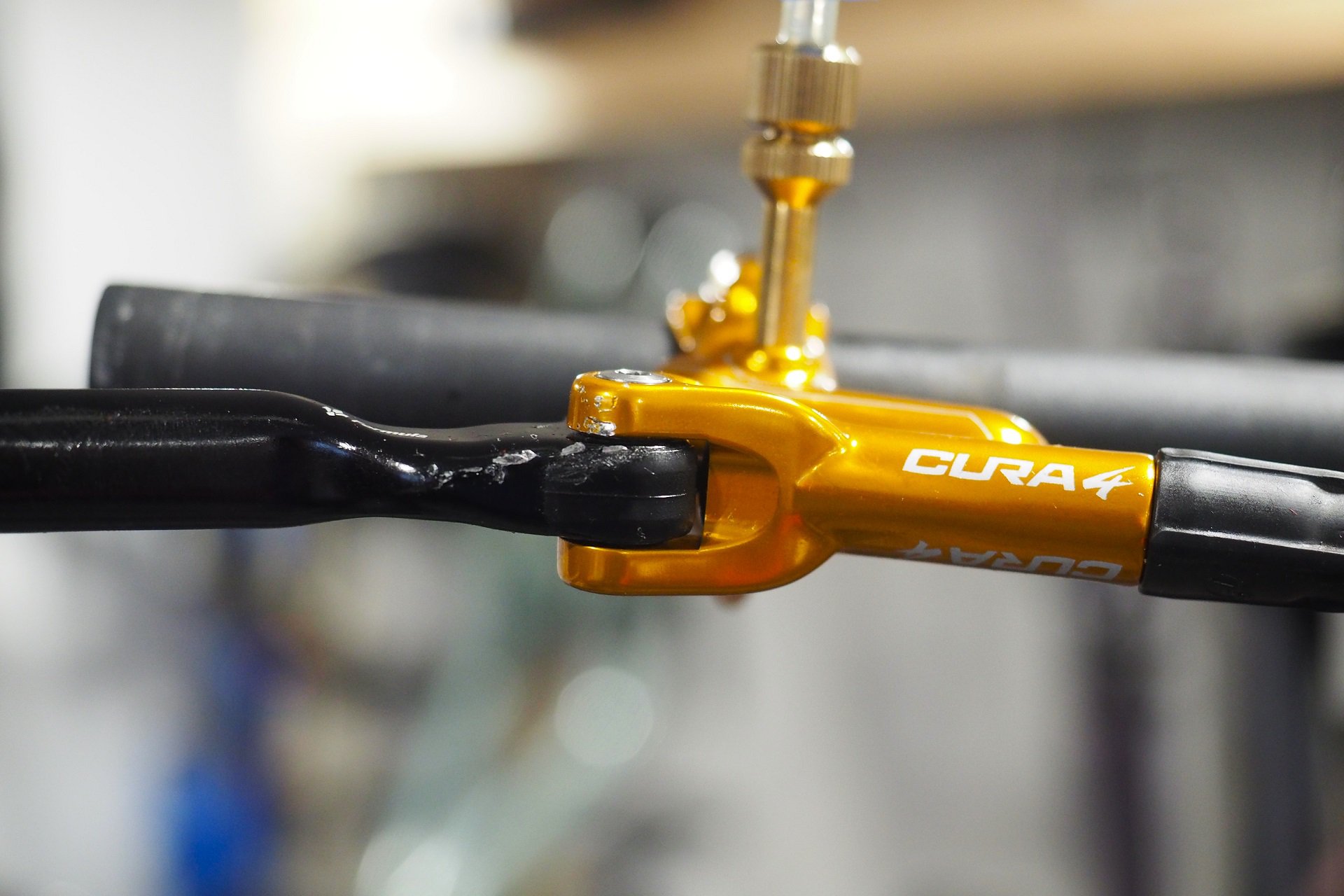
Even cleaned up and functioning as new, these brakes show lots of signs of use. I know this isn't everyone's preferred aesthetic, but I love it.
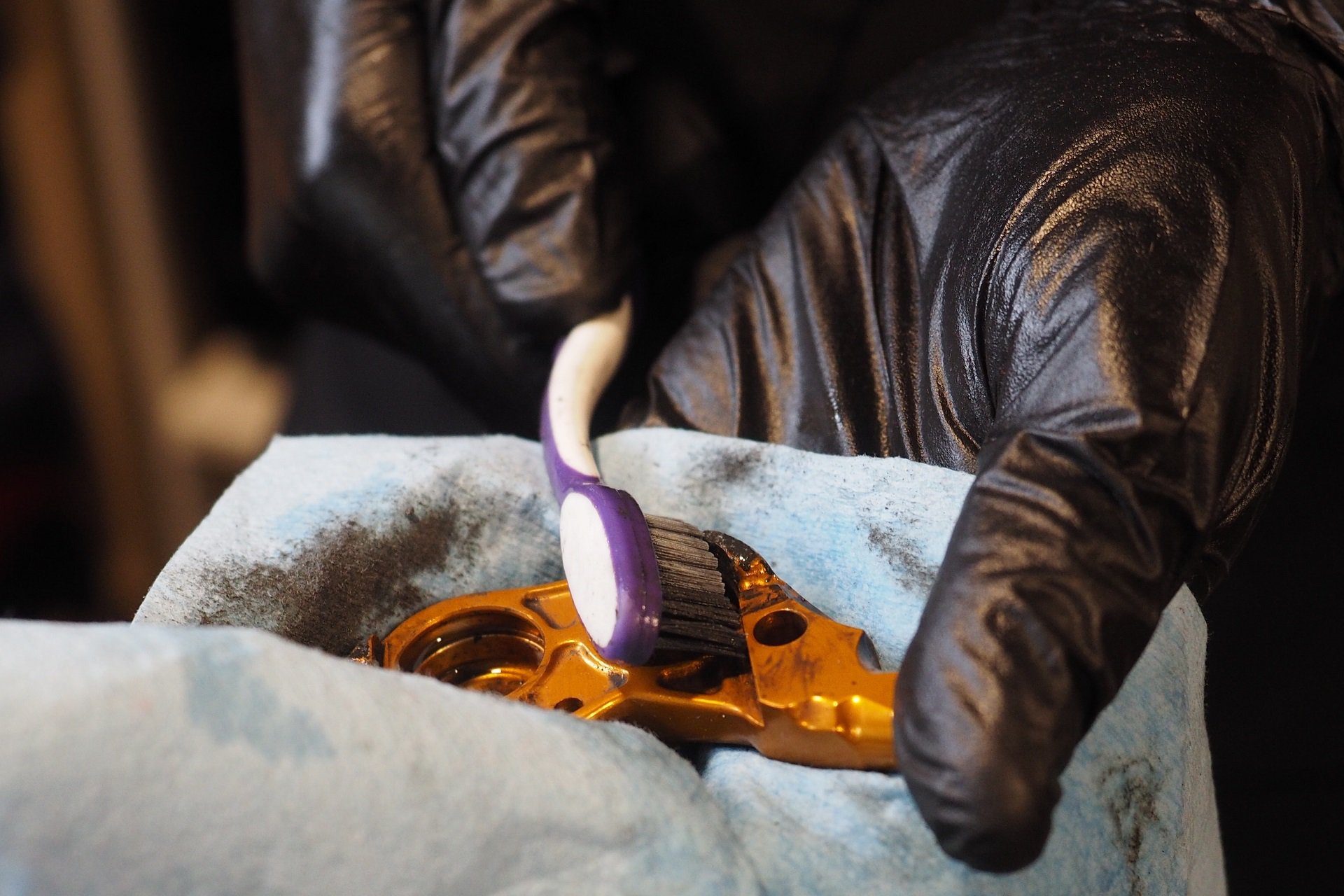
Don't know how I missed including 'Tooth Brush' in my piece Everyday Bicycle Tools but if you don't have one in your tool kit you'll use it way more than you'd think.
Half-Life
With nothing but a routine bleed - minimum every 100hrs of riding/yearly regardless of the fluid you use - all brake systems have a half-life. There's a certain point where no matter what you do to try and clean and lube the pistons or get gunk out of the master cylinder assembly, the brakes just aren't as good as they were. Eventually, any set of fresh budget brakes would be an improvement. Once you reach that half-life, which may differ from rider to rider and from system to system, the performance curve just drops off precipitously. The lever blades get sloppy, the braking action feels spongey, the pistons don't retract properly. Modulation is heavily damped and with some systems brake drag becomes an issue.
There are two obvious schools of thought with disc brake systems. Some manufacturers will sell you a master cylinder, caliper, or brake line and are clear that their systems are not meant to be serviced past that point. Once these systems hit that half-life, it's time to start budgeting for a replacement. Other manufacturers will sell you everything you need to reconstitute an older brake system, although how long they support past systems varies from brand to brand. I've had good success tracking down small parts to rebuild recent systems from SRAM, Formula, Hayes, and Hope. Hope gets the crown for how long they support their systems with Formula in second place. Depending on where you are in the world your experience may vary.
One interesting note is that, of those companies, only Formula is* making a high-performance, fully rebuildable, brake that uses mineral oil for fluid. And, that only started with the release of the Cura 2 brakes, as their previous systems used DOT brake fluid as well.
*This may now be deba8able.
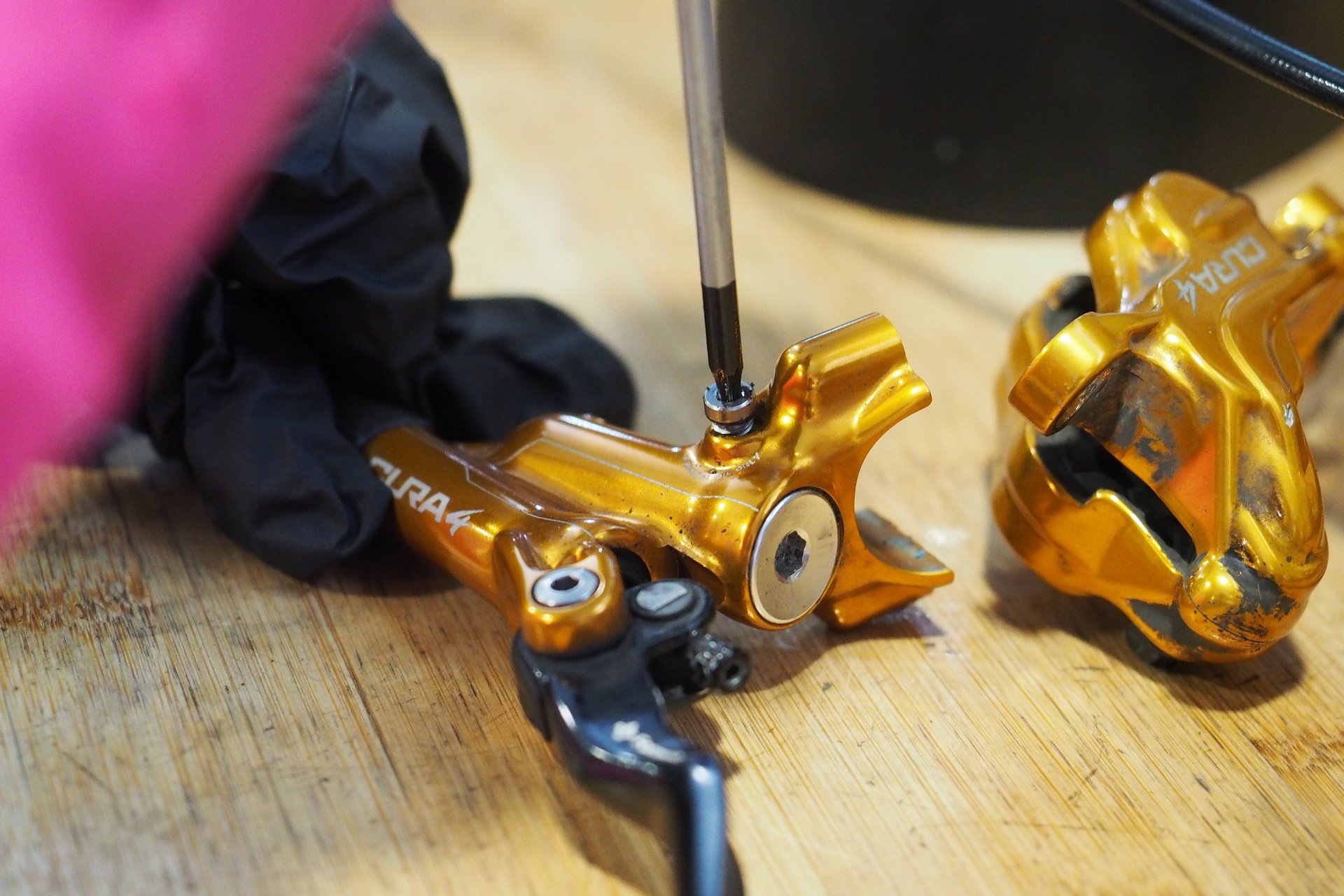
Remember to always open a brake system before pushing the pistons back in, whether it's to swap in new brake pads or as part of a service.
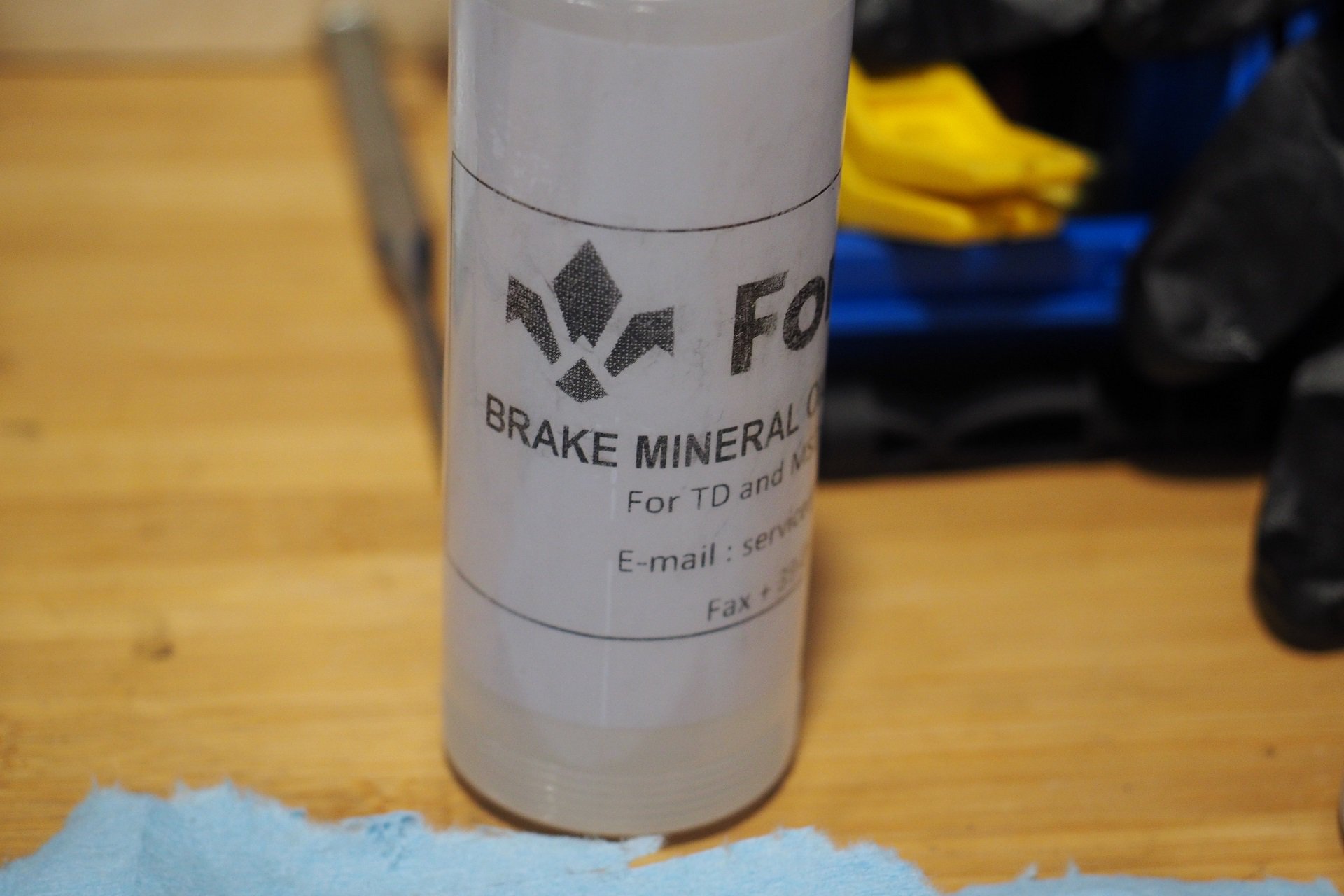
I used to have a strong preference for mineral oil brake systems, but that's been damped over the years. Brake fluid is only part of any system's story.
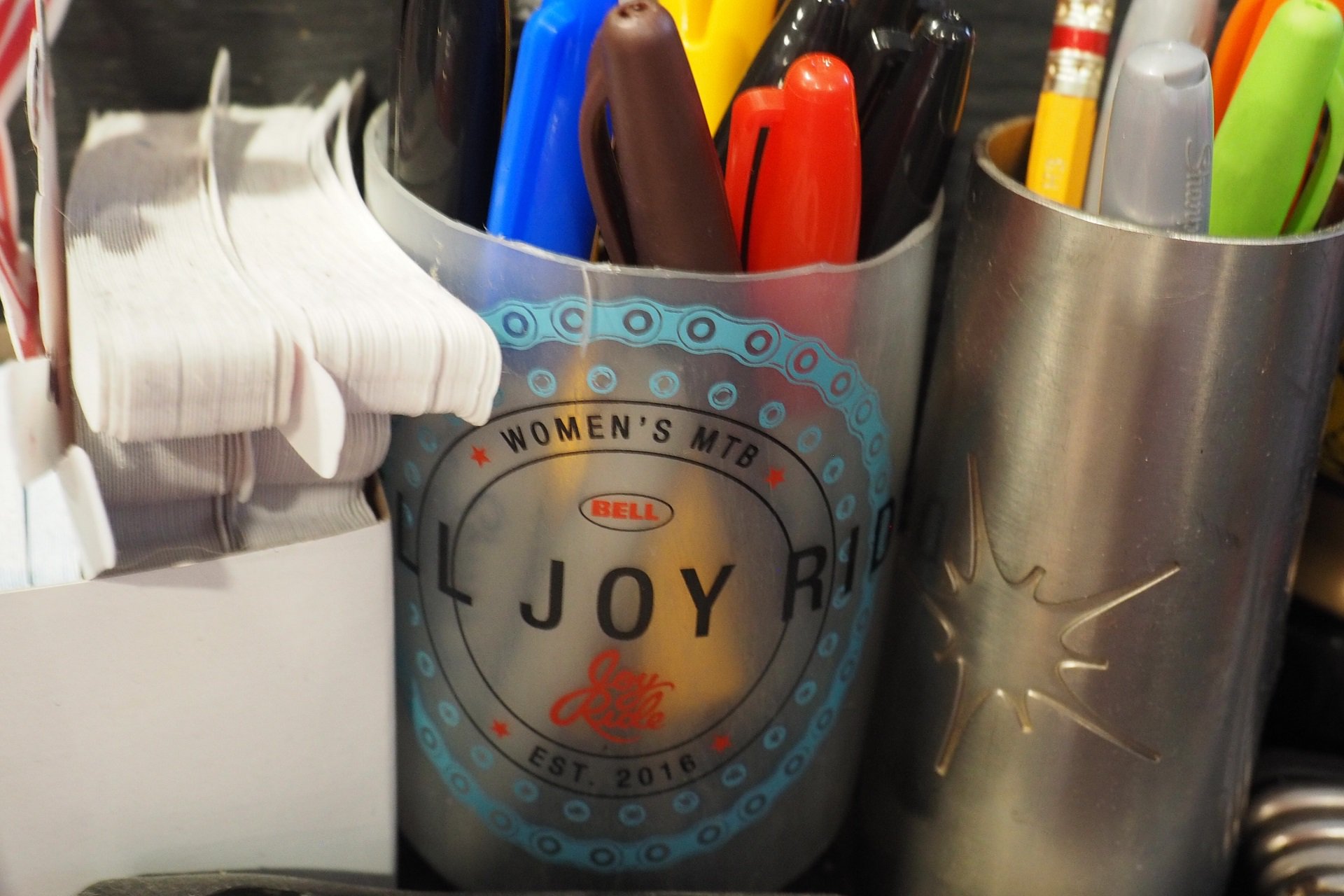
A non-serviceable brake is like a helmet. You can choose to keep using it long past its half-life but at some point it's a bit 'meh.'
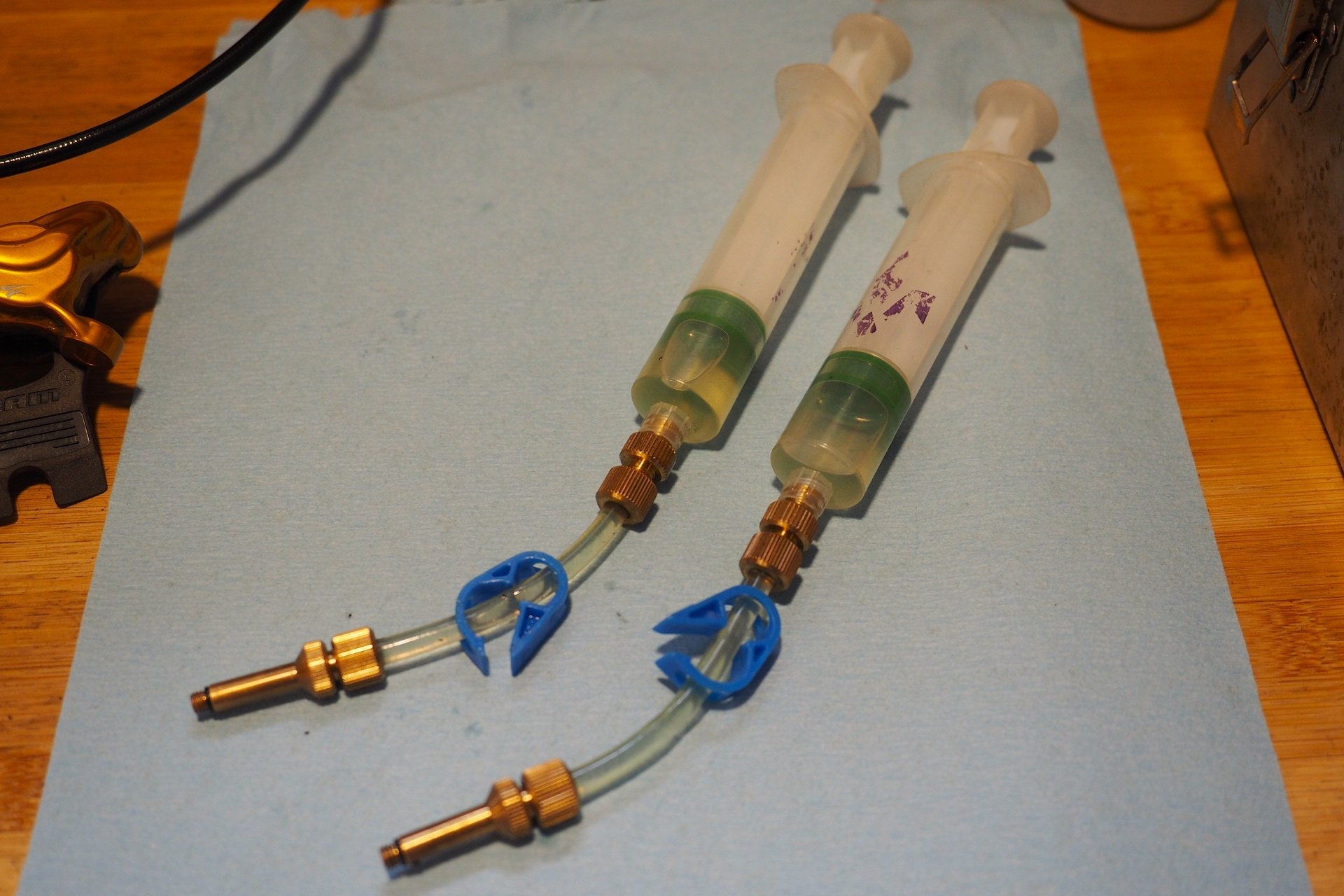
Formula sells one of the nicest to use bleed kits on the market. The plungers are so smooth. The fittings engage so nicely.
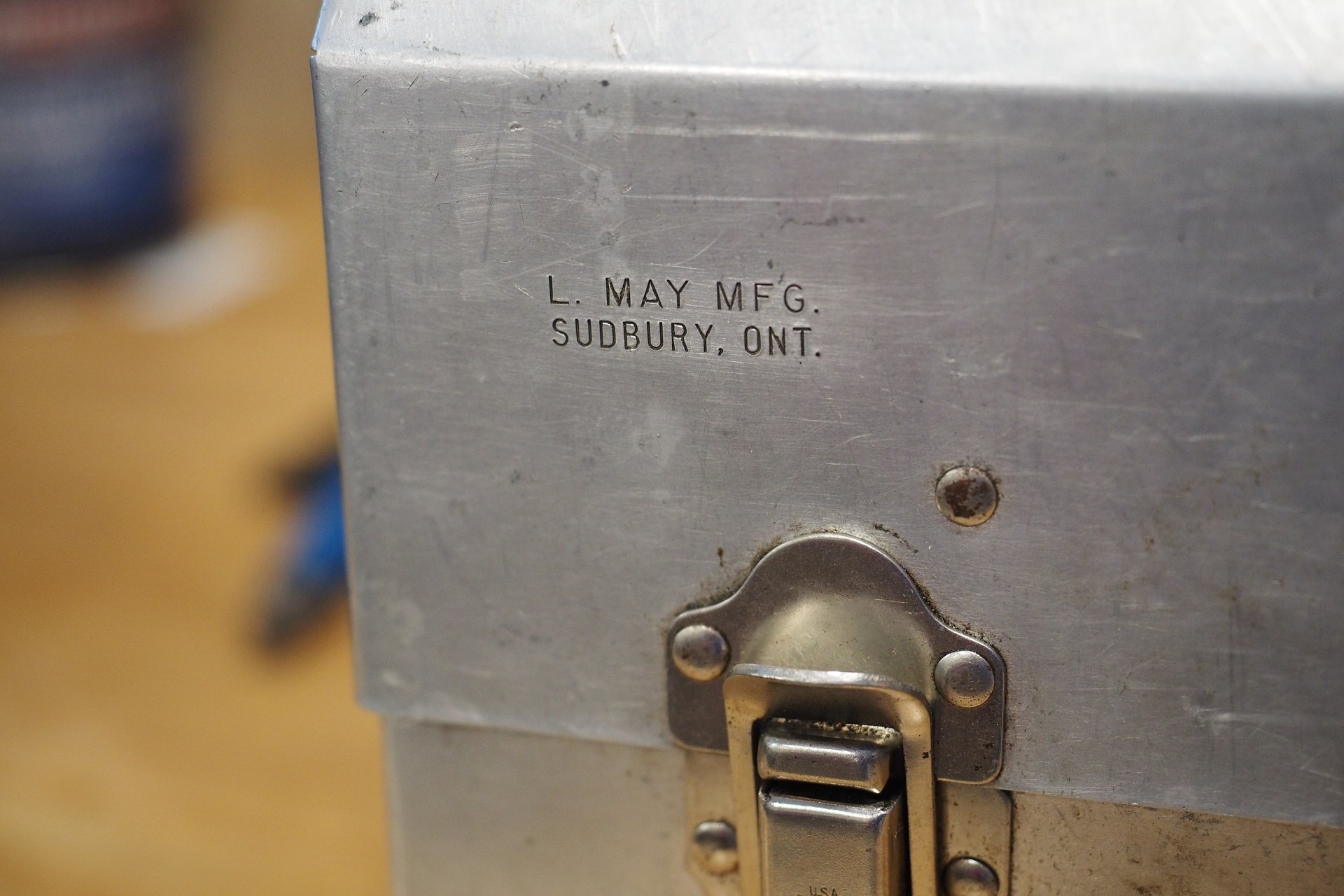
Amortize your life. Insert some rant about paying more up front for stuff that will last forever.
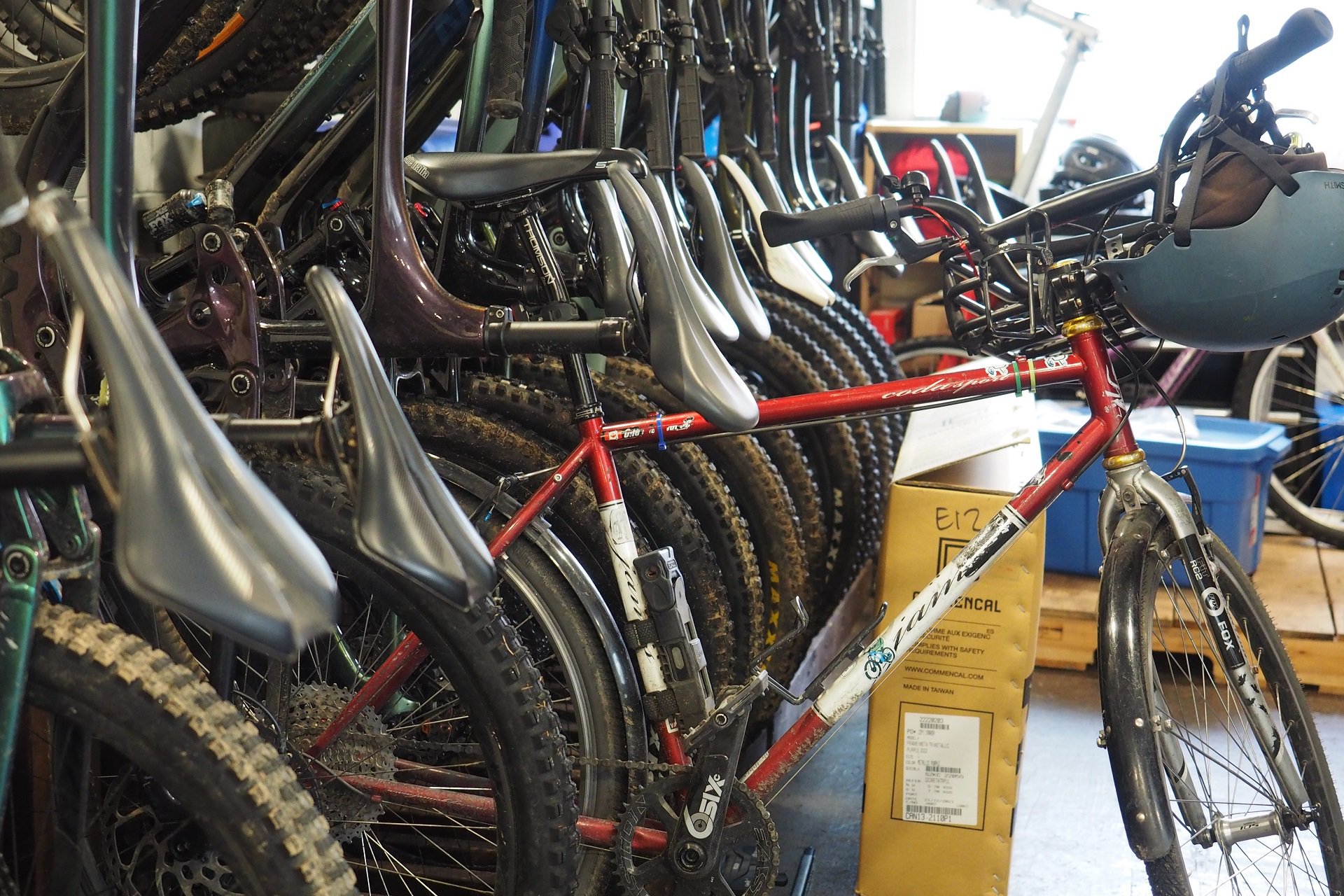
A proper 'bike mechanic' commuter bike. My favourite detail may be the mis-matched carbon crank arms but the one-piece bar basket is sweet too.
Pulling the pistons out of this brake (and this has also been my experience with properly-cooked Code and Guide brakes) was not what I'd call easy. Likewise, while the layout of the bladder system is very different, the master cylinder pistons are similar between the Cura and SRAM brakes in more ways that just appearance. Getting that little circlip out without damaging it is a bit tricky. If you're installing a new piston kit, it's easy to just flick the circlip out with pick, but re-using everything is a little bit more of a process. I bring it up because, even with a premium system like the Cura, the service cost will add up quickly.
I'd estimate that rebuilding both master cylinders, both calipers, and bleeding both brakes in the same conditions as my system is going to run at least two, maybe 2.5, hours of shop time. Shop labour rates vary, but that could easily be half the replacement cost of the brakes, not including installation. It would save substantial labour time to just rip the guts out but the parts costs add up. A piston kit for a Cura 4 caliper is 56 CAD per side, o-ring kits are 24 CAD per side, a lever kit is 30 CAD per side, a bladder kit is 30 CAD per side, and a master cylinder kit is 19 CAD per side. It's doubtful that all those parts would be needed for either brake, but that's 159 CAD per brake plus labour if they were.
If I had been tackling this job myself, I'm positive I would have needed a caliper piston kit between the two brakes, since I'm not a master at twisting out stuck pistons. No matter the brand, they're easy to damage. I also would not have removed the bladders as part of doing my own full teardown service. The risk of tearing one is real and any performance advantage of cleaning it is dubious. That said, I've had to recycle a lot of non-serviceable brakes in the shop because of folks rupturing bladders by forcing pistons back into place to change pads, without first opening the system. Any of those people would have been delighted to pay 30 CAD to get their system working again. It's a nice feature to have.
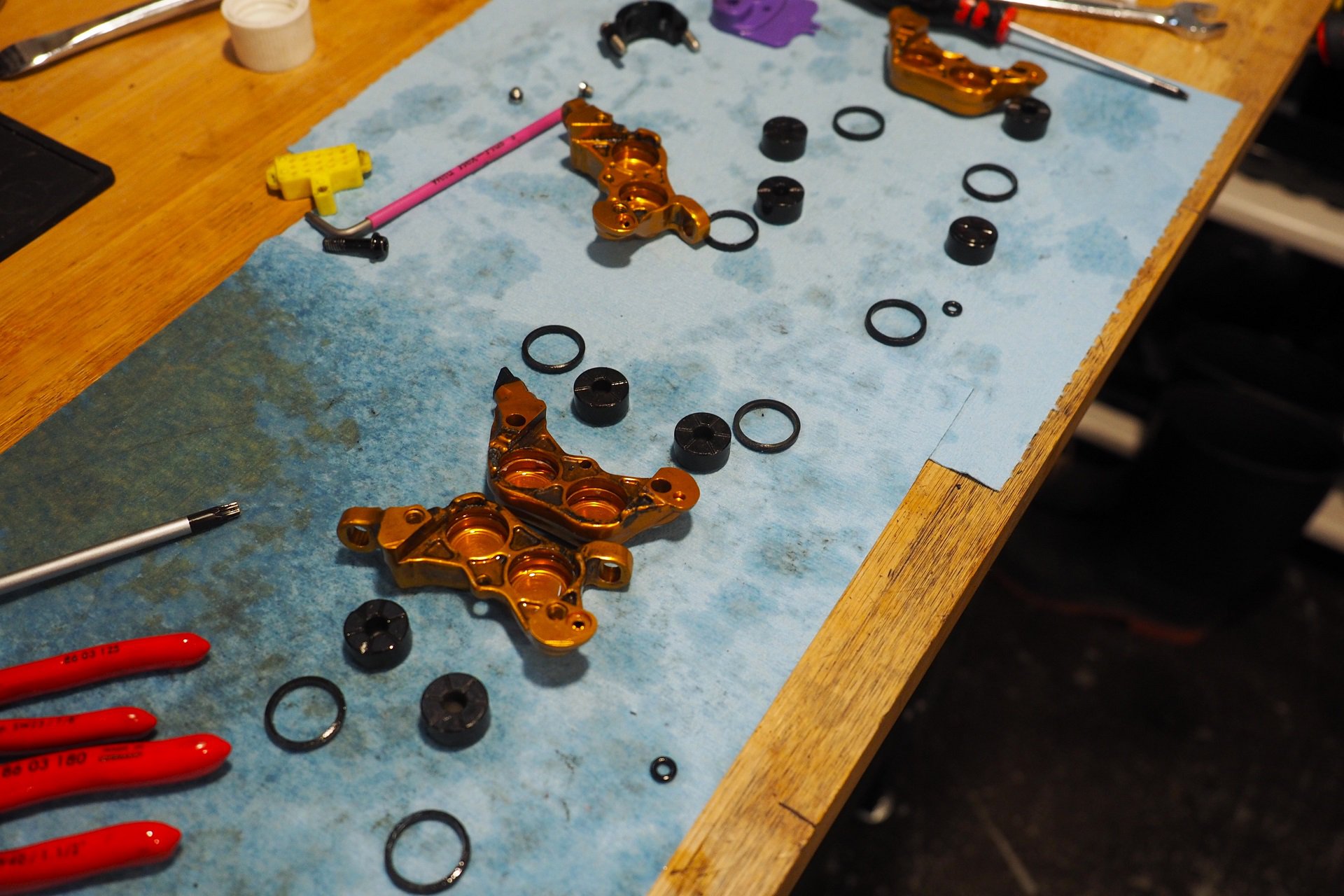
Removing seized pistons without damaging them is certainly the hardest part of the job. If this is something I was tackling at myself and I wasn't willing to take a chance on downtime, I'd have a pack of Cura 4 caliper pistons on hand. That's 56 CAD or $14 per screw up weighed again the cost of a replacement system.
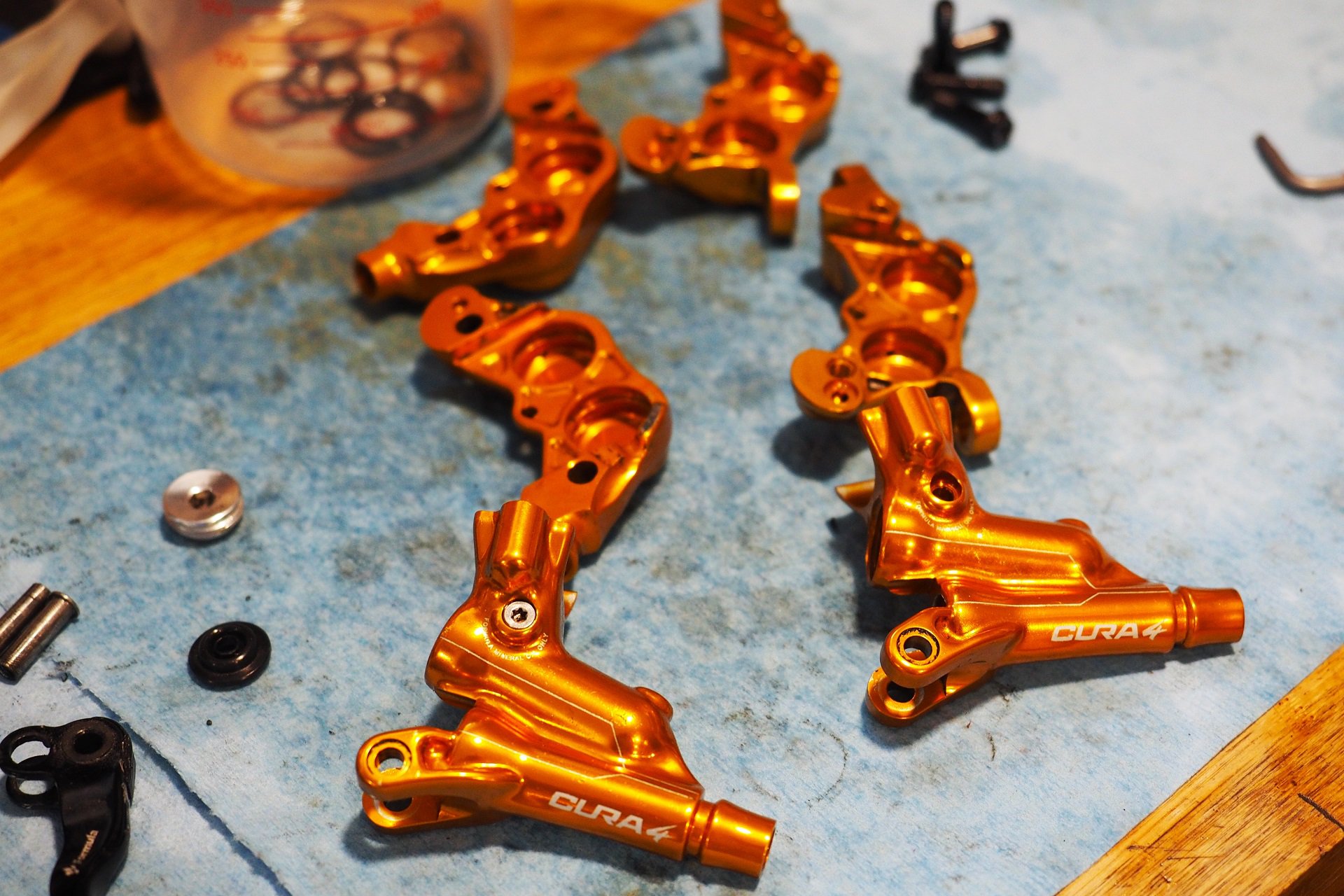
We took these all the way apart, because we could, but on my own I would not have bothered to remove the bladders from the master cylinder unless they needed to be replaced. Removing the brake lines also would not have been necessary. I would certainly take out the caliper and master cylinder pistons.
The Serviceable Mentality
Choosing to buy a product that is more serviceable, and then choosing to service that product instead of replacing it, is a personal decision. In my years working in service businesses in the bicycle industry I've come to understand that many people have the mentality that paying to service a product is akin to paying once again for something they've already bought. I always come back to suspension where a full service and fresh seals on a fork will often result in a better-than-new product but folks will buy a fancy carbon handle bar to 'dampen vibration' on a rig where the fork has so much stiction that measuring sag is impossible. This is an example I've seen play out many times and it's always something on my mind when talking about 'noise cancelling' products. There is no point in investing in Rev grips, for example, if your suspension isn't working properly.
I stay on top of my brake bleeds and the fluid that came out of my Formula brakes was almost as clear as what we put in. It's a far cry from the average mineral oil brake that I've bled where the once pink or blue juice looks like I just poured a shot-in-the-dark. Just bleeding brakes doesn't keep the master cylinder or caliper pistons moving smoothly. Further more, I fully reset the pistons on all my brakes as part of my bleed procedure, so if that alone lubricated caliper pistons then coupled with my routine bleeds things should be moving fresh at the rotors at least. You can try extending the pistons and lubricating them externally to lube the piston seals. I'd recommend doing a bit of reading before going down that trail. There are multiple opinions out there about whether or not this is beneficial.
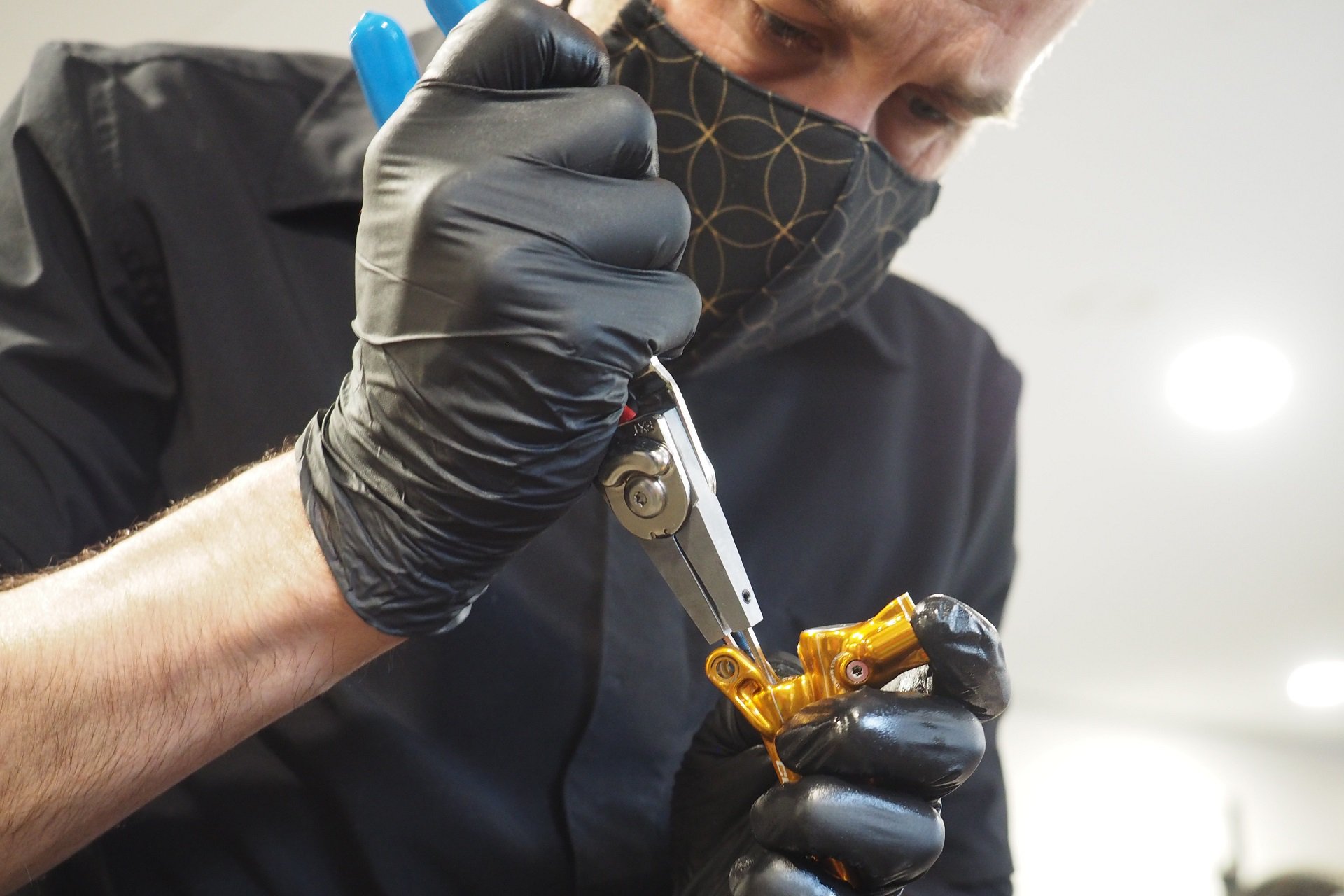
This is an easy task if you're prepared to mangle the circlip. Removing it in 'to be reused' condition is tricky, but installation is relatively easy.
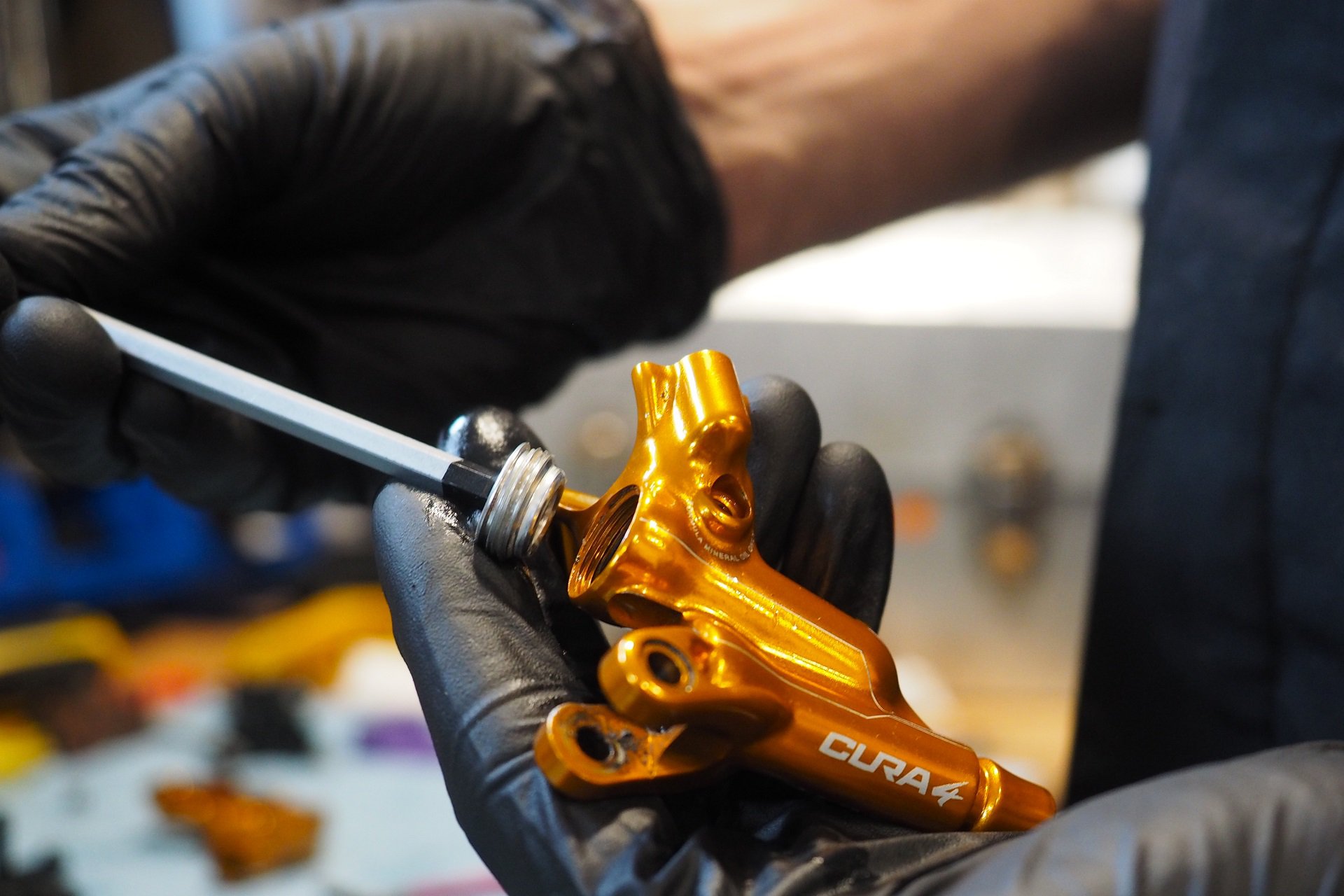
At the very least every brake should have a replaceable bladder. I've seen so many master cylinders scrapped due to riders not opening their systems before pushing back pads.
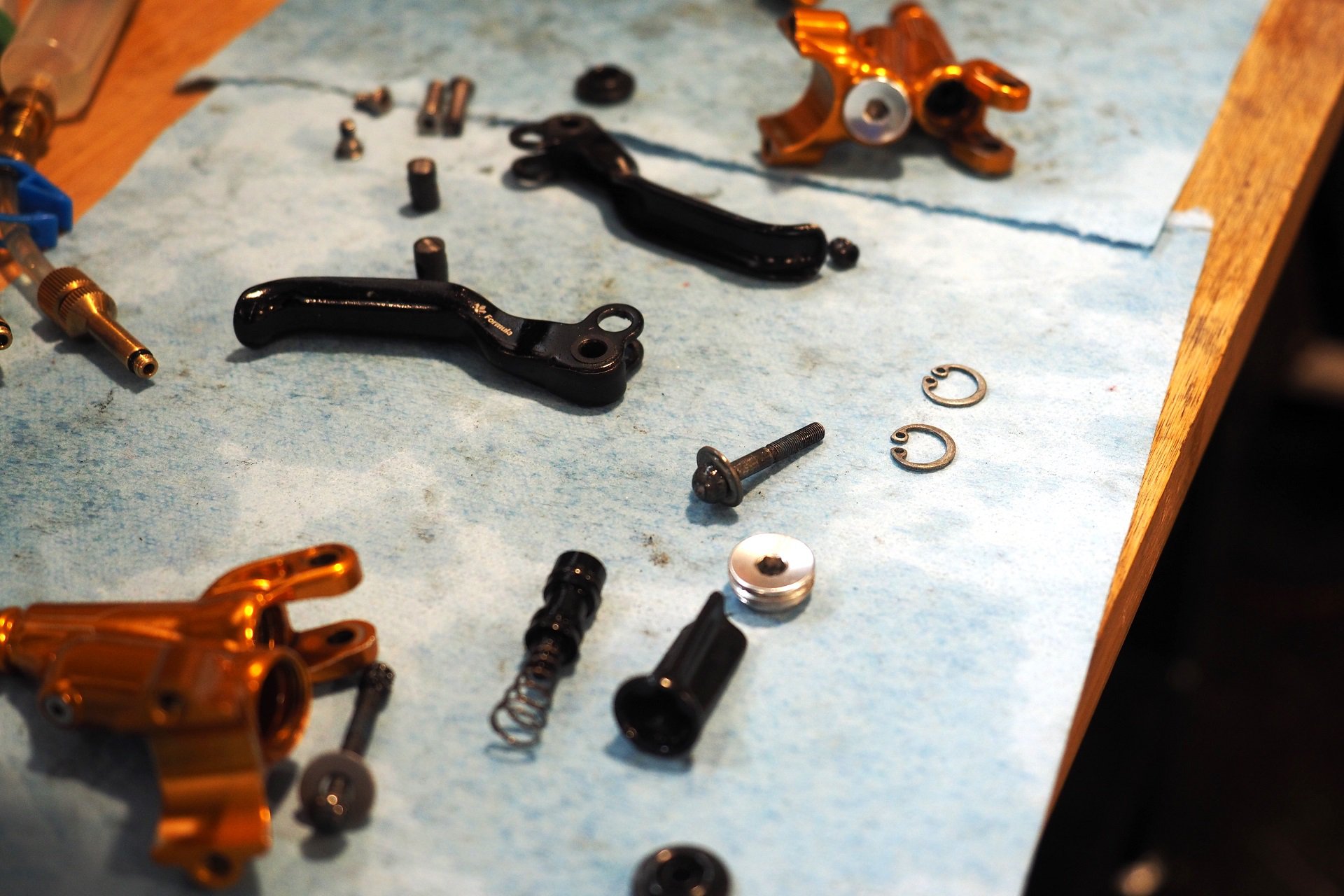
I need to make some very thin shims for the brake levers as there's a bit more slop than the brakes had when they were fresh. It's currently the one notable difference between brand new and rebuilt.
Circling back to the costs, the relative value is going to vary greatly depending on the rider and their tolerance for parts that work like sh*t. Unlike the 100hr/yearly brake bleed, a full teardown service like this isn't something I'd prescribe any set timeline to. Probably the average rider will go happily along for a many more years than I have here and some may prefer to do the full reconstitution every annum. When your brakes feel crappy, whether it be after a year or a decade, then tear them down, or, if you're not running a fully serviceable system, replace them. Compared to the cost of new brakes that I would have been buying at this point, it saved me at least half the cost of a fresh set of Cura 4 brakes to service these ones.
I think it's fair to argue that there is an upfront premium paid to ride a serviceable, and fully small-parts supported, brake system. At around 280 CAD per wheel for the Cura 4 versus, say the excellent Magura MT5 at around 220 CAD per wheel, I'd call that a premium of 120 CAD for a set of brakes locally. The Cura 4 is also made in Italy, versus Taiwan, if that matters to you but in terms of performance from a mineral oil system I think they're comparable. I have hundreds of hours riding both systems. The true added value of a completely serviceable system is only realized if you service it. Put another way, I'm always keeping an eye out for a near-free set of used brakes that are fully serviceable and supported because a lot of folks would rather buy new than service what they have.
A counterpoint is that I have a friend with a set of once-premium four-piston brakes that have maybe been bled twice in the last five years despite regular use. They're awful. The pistons don't fully retract and the master cylinders feel like they have a damper built in when you pull the levers. I can't imagine what the fluid looks and smells like and I'd be wary of putting a syringe on them less everything rubber inside the brakes disintegrates at the same time, flushes out with the pressure, rendering them completely unusable. He'd tell you that the secret, and this extends like a force field over his whole sloppy sled, is to never try anyone else's bike. As with the last bike, at some point he'll sell the whole pile of slag and start fresh with a mind blowing new bike that will instantly demonstrate the value of the new-new in the difference of on-trail experience.
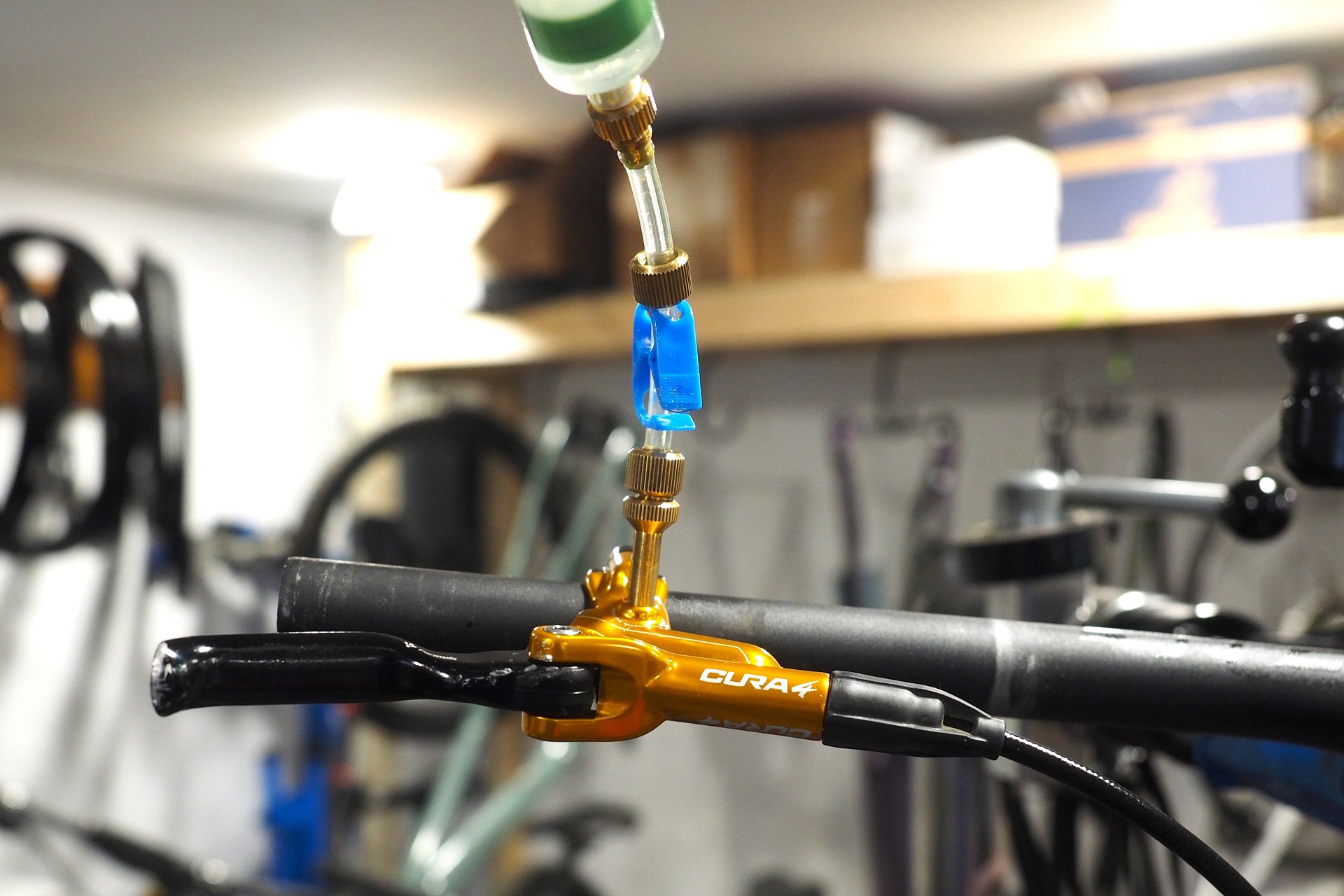
Formula uses a two-syringe bleed setup like SRAM, Tektro, and Hayes. I'm successfully bled these one-way, à la Shimano and Magura, as well.
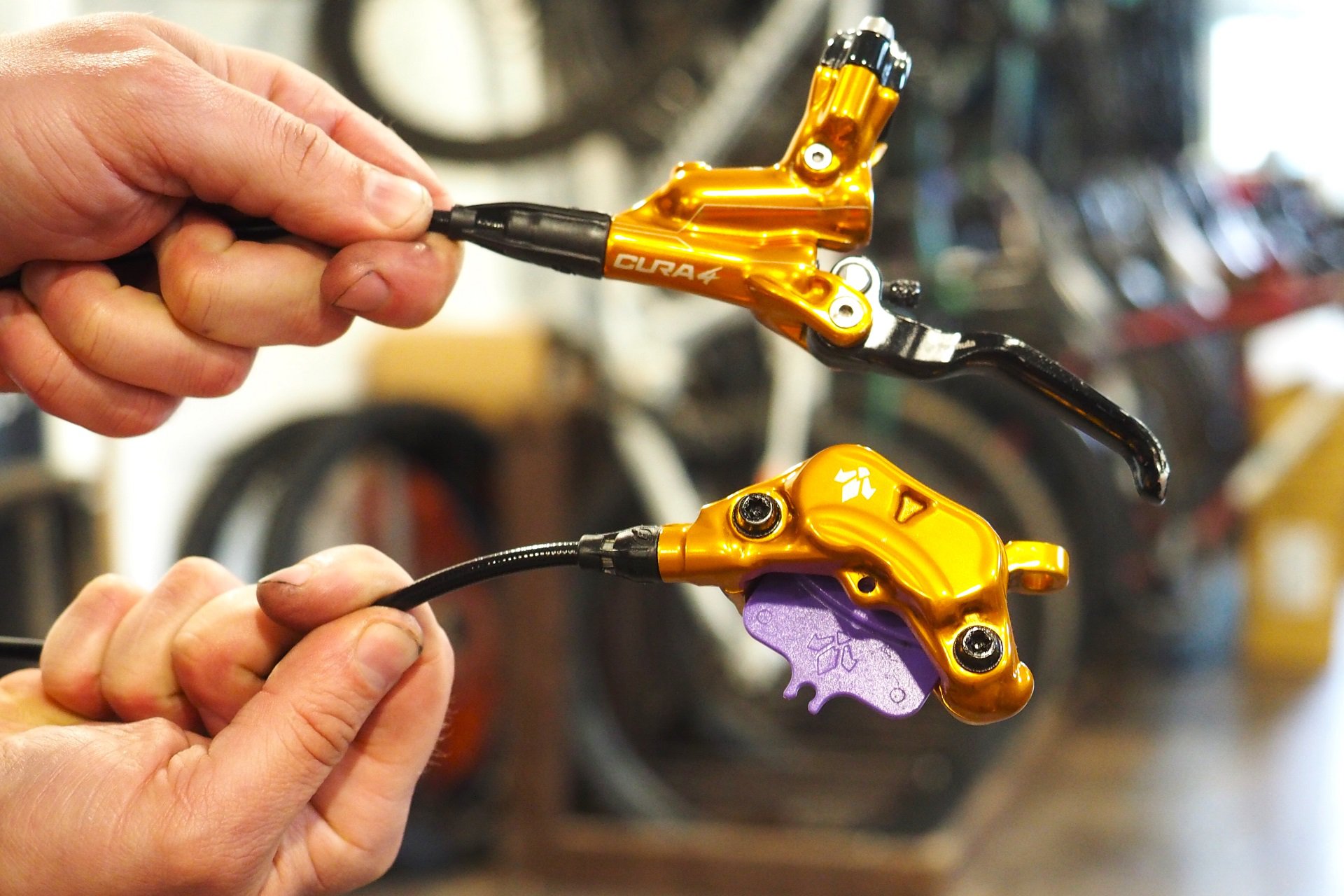
Maybe not quite 'as new' but impressive given what they've been put through and a solid value compared to replacing the system.
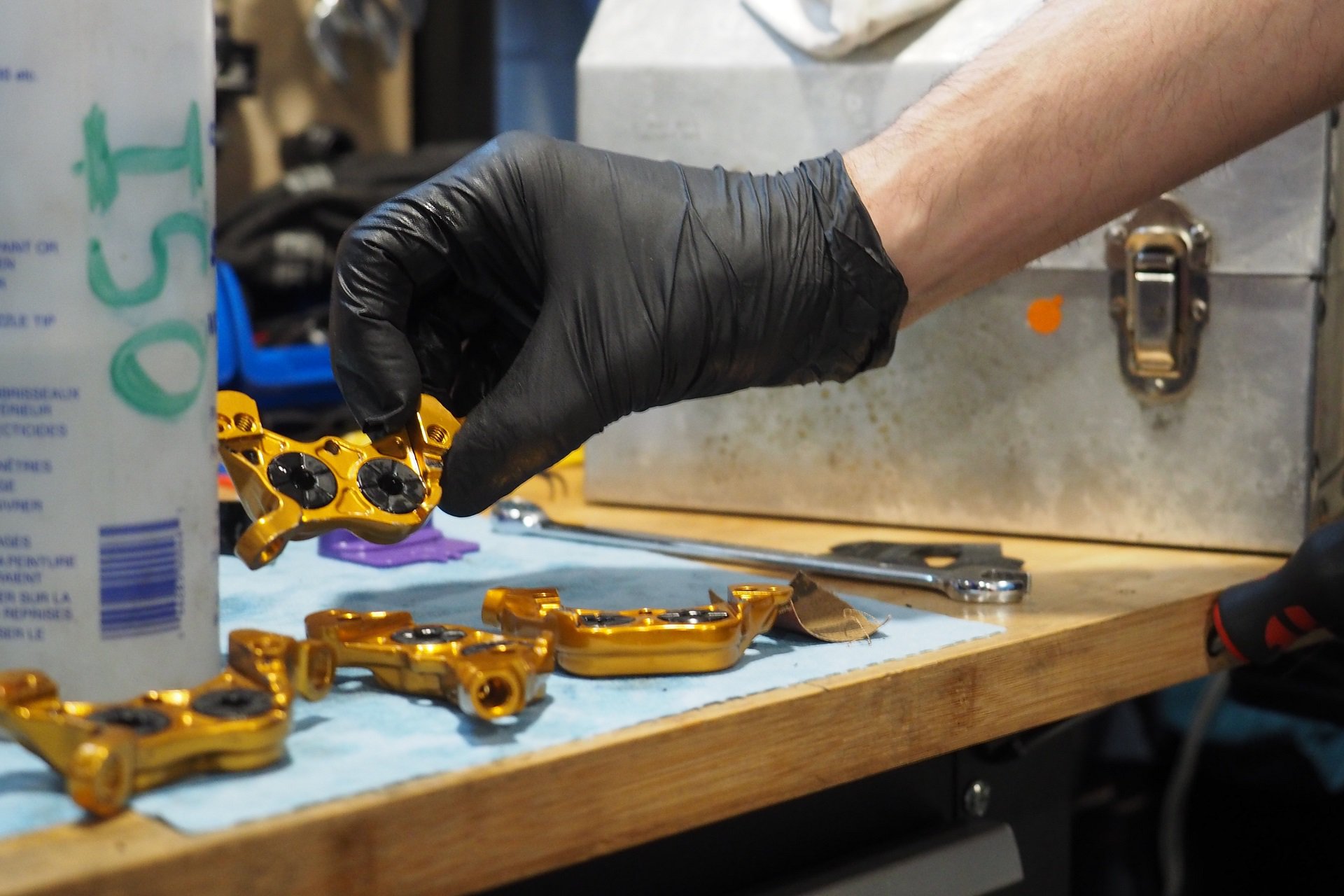
I noticed how bad performance had become, compared to new, thanks to my frame of reference riding and working on other brakes.
Anecdotally, more riders seem to be keeping their bikes longer than even a couple years ago. This may come down to pandemic product shortages, or just the level of maturity that self-powered mountain bikes have achieved, or even the marketing and design energy that companies are pumping into Bropeds instead. Maybe it also speaks to the economic realities of riders who have seen the loaded carbon super bikes increase in price outside of their comfort zone but would rather put some money into their few-year-old S-Works than buy a fresh rig that's more mid-level. Budget bikes are the best they've ever been and what you can get for 4K is astounding, but when you're used to riding XX1 you want to ride XX1.
If riders are servicing and updating their bikes, rather than replacing them outright, does that give an edge to replacement components that are themselves more serviceable? I don't know if we're there yet if only because I don't see, for examples, SRAM, Hayes, Hope, and Formula making much effort to market how well their products are supported with service parts and how this level of serviceability is part of their design ethos. But, I think it's coming. And, as part of that, we'll see less new product releases year over year as serviceability becomes more important for revenue and for the ridership and hopefully more support for truly long-term multiple rebuild reviews. My Hayes Dominion brakes have seen fewer hours and still feel brilliant just with routine bleeding, but they'll be do for another look in the future as well. I'd also like to come back years from now and look at these Cura 4 brakes inside out again.
We're at a point where the best brake five years into the future may be exactly the same as the best brake today. I don't mean exactly the same design but actually the exact same brake. That has to be exciting for riders and folks that service bikes, and, maybe a bit terrifying for companies that make bike parts, particularly bike parts that aren't serviceable.
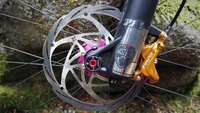
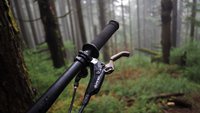
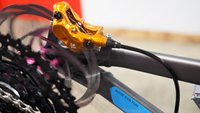
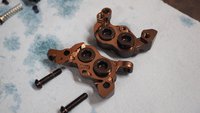







Comments
SeannyD
1 year, 11 months ago
Great article! The financial cost of buying a new set of premium brakes with every new build or every time the performance falls off in need of service is one thing, but I don't think too many people out there are aware of the environmental cost this imposes as well. While this is not a direct cost to the consumer, it impacts everyone in the long run and seeking out brands that sell and encourage replacement parts and service compared to an outright system replacement (cough cough SRAM) are inevitably delivering a better tomorrow for mother nature and your wallet.
I have been running TRP's for the last 5 years on a couple different frames and have rebuilt two of my systems (Slate T4's first and then the DH-R EVO's) using new hoses, caliper pistons, and seals, all of which I was able to source for just a couple bucks through their US service center. While this did also cost me time and a couple beers to tear them down and rebuild, it was way cheaper than buying a new system and it didn't add another hunk of aluminum to the garbage heaps. I feel brands like TRP that create and innovate on new products but also see value in and support replacement parts to refurbish past products are going to start catching on with more and more riders.
Reply
Andrew Major
1 year, 11 months ago
That’s good to know TRP’s after sales support is great in the USA.
Not sure why you’re cough-coughing SRAM? Their small parts support, as I noted in my piece, is excellent.
I’ve reconstituted a number of SRAM brakes that would have been retired if they were from other brands. There’s a reason I singled out SRAM, Hope, Hayes, and Formula a few times. In Canada their small parts support, in my experience, has been excellent.
Reply
DancingWithMyself
1 year, 11 months ago
Agreed on SRAM. Putting aside buying local and such, in the States you can get SRAM small parts from Amazon (often prime), which is about as easy as it gets to buy something and have it relatively quickly.
However, I do wish they would sell piston seals separately from the whole master cylinder kit.
Reply
Andrew Major
1 year, 11 months ago
Why putting aside buying local? I’d expect any mountain bike focused shop to have current SRAM master and caliper kits in stock. I mean, online’s always an option to, but this stuff is certainly not hard to find locally around here.
Piston seal kits so that if one gets damaged removing them to sand down the piston a bit you don’t have to buy a whole lever rebuild kit? That may be a wish too far. I’ve only seen those damaged occasionally by folks trying to remove them.
Reply
Vik Banerjee
1 year, 11 months ago
I'll be keeping my eyes open at the LBS for serviceable brakes that are being thrown away. Maybe start a bin in the shop for that and then when I have a few sets spend a rainy day making a working set or two out of them and keeping any partials in good shape for spare parts.
The fact people will blow big $$ on new parts so easily and few/no $$ on service or coaching or suspension/bike setup for their MTB hobby always blows my mind. There are a lot of expensive high performance machines out there running well below their design potential.
Reply
Andrew Major
1 year, 11 months ago
The first set of free Guides I acquired for Claire’s bike was simply a matter of downtime when every shop was slammed during the pandemic. Getting new (genuinely upgraded) brakes was way faster than getting old Guides rebuilt and the owner wasn’t interested in paying to have them rebuilt as spares (fair enough). They ended up replacing some awful brakes on Claire’s 20” that had started micro-leaking fluid from the calipers.
Reply
awesterner
1 year, 11 months ago
I hope those didn’t give you too much grief in rebuilding. Very, very, very well used brakes haha ;)
Reply
Andrew Major
1 year, 11 months ago
Nope! They’re perfect. And I’ve talked to a few peoples whose kids have been given the gift of Guides so thanks for leading the charge!
Reply
awesterner
1 year, 11 months ago
This is a piece that hopefully inspires some more hand me down action. And after seeing images of Morgan rolling two bikes to Our Community bikes, I’ll be taking the old rip around city bike down for a better life than it’s living in bike storage!
Reply
fartymarty
1 year, 11 months ago
Vik - I recommend Cura 2s. Picked up some for £80 an end. Thanks to Mr Major for the recommendation.
Reply
Timer
1 year, 11 months ago
One problem is that buying new stuff is easy and convenient. You just need money.
Servicing is not convenient, even if you have the money. And it takes time, which is even worse. Unless one can pay a mechanic to do it, but i wouldn't even know where to start looking for a shop that would reliably repair and rebuild Formula brakes. And even then, paying first world wages and spare parts at msrp + markup, its often cheaper to just buy new.
TL:DR: We need better service and repair infrastructure. Fast, efficient, affordable.
Reply
Lynx .
1 year, 11 months ago
It's purposefully this way, setup by manufacturers, so they can turn over more product and make more $$ selling shit made cheaply in China instead of paying proper wages to someone in a "western" country, they don't give a rats ass about the environment or what this whole throw away mentality does to it, they and their share holders just want more profit.
It's up to us, as consumers to buck that trend and demand better, but these days it seems, everyone wants to have their cake and eat it too and that can never happen - just look to the US and it's citizens bitching about loosing jobs to Asia and then flocking en-masse to buy the cheap Chinese shit from Wallmart because they don't want to pay for stuff produced by people like themselves, earning a decent wage.
Reply
Andrew Major
1 year, 11 months ago
This may be a bit indirect as a response to your comment, but it fired me so here goes.
Surge pricing. There’s excess labour in the bike service works at some times of the year (most places) and at other times of year, due to many factors, there’s a massive labour shortage.
Locally it’s rent v. wages v. the experience of working a skilled retail job (customers).
One way to increase wages is to have shops busy year round and for at least four months of the year (locally) turning around a brake service is a couple days max for most shops.
———
Certainly I agree price becomes an issue if we’re day talking about a set of basic Guide brakes. As I noted, service is sometimes about making a choice.
But, also noted, this set of Cura4 brakes (labour only) was less than 1/2 the replacement cost (SRP / CAD) to fully service.
Reply
cxfahrer
1 year, 11 months ago
Great read, thanks!
As for the consequences for manufacturers, it will follow the same path once innovation gets to a certain point - they will focus on making everything cheaper and even more unserviceable, as with TV sets and washing machines (my still perfect washing machine is from 1986!).
It will be interesting to see where this leads to with bicycles.
Reply
Andrew Major
1 year, 11 months ago
I feel like the cheaper ‘throw-away’ brakes are here already (the ones that are such trash they get replaced when it’s time for that first bleed) but maybe they will get cheaper yet?!
Brakes are so key to the riding experience. I always say I’d give up suspension before I’d give up good brakes (hahahaha).
I do hope that as a society we’re on a path back to more serviceability and less toss-and-replace as a mentality. But I have nothing to back that up - if wishes were fishes right?!
Reply
Lu Kz
1 year, 11 months ago
Now that Shimano sells a totally acceptable brake at $60 CAD per end, I'm finding I'm selling a lot more of those than bleeding older/not amazing systems. Yes, they have the long levers. No, they're not four piston. No, they don't have servo-wave either. Yes, they run the worse pads. But they're $60 CAD retail. They might be the best performance-price brake on the market. Am I about to run out and pick up a set for myself? No. But when someone comes in with an old DOT systems with rebuild kits confined to the realms of eBay, they become a very attractive option.
Reply
Andrew Major
1 year, 11 months ago
I’ve written about Shimano’s m396 brake in the past and used to recommend them widely for commuting and budget applications. Sure, if a brakes not supported I’ll be recommending a replacement, but why not spend a couple bucks more for a Level or Guide that’s serviceable?
Reply
Lu Kz
1 year, 11 months ago
Even the lousiest of guides MSRPs for more than double the above Shimano brake. It'd be one thing for a consumer to grab a friends set of old guides and bring them in for us to rebuild, it's another when we're usually talking resurrection on a budget COVID-style bike refreshes with customers who are maybe not so on top of it as your regular readers, we'll say. Can't remember where the Level slots in because we've been waiting for them for longer than I can remember at this point. Haha!
Reply
Andrew Major
1 year, 11 months ago
Re. Pricing, that’s a solid summation of my piece. Spend more for something that’s serviceable and supported, or choose a toss away product for a smaller up front investment. And at the budget end it’s not like the value proposition is as good with labour v. replacement.
But, why not offer a product like a Guide T or Level T? Shop makes more money and the rider has the opportunity to choose a product that is serviceable and then in the future whether to service it.
Cr4w
1 year, 11 months ago
Ha! My mom is still using the same dishwasher and laundry machines she bought in 1987. My condo's dishwasher failed within two years, the day after its warranty expired.
Reply
Andrew Major
1 year, 11 months ago
My experience as well. Dishwashers, fridges, and stoves. I have had good results fixing my dishwasher and fridge though. Even the cheapies you can often get parts if you take the serial number to an appliance repair place.
Reply
Vik Banerjee
1 year, 11 months ago
We just fixed a 10 year old oven. A painful $600 repair. However, looking at the cost of new plus the thought of sending an almost working stove to the landfill we decided to repair it and hope we get another 10 years out of it.
Reply
Timer
1 year, 11 months ago
While its true that the some of the older (usually high-end) stuff lives longer than current (usually budget) machines, there is a large dose of survivor-bias at play.
We compare the few, decades old, machines that are still working with all the modern stuff that broke last year. But we have totally forgotten about the heaps of old stuff that already broke many years ago.
Reply
Andrew Major
1 year, 11 months ago
I read a similar comment quite often but, yes, anecdotally, I have a hard time processing it from my own experience.
I admit, I don’t own anything high end, but in my lifetime we’ve arrived at a point that I’m not surprised that ALL my appliances needed to be fixed or replaced essentially right after the warranty expired (I had to fix my fridge in the first month of ownership - thanks Samsung / my temperamental oven is unfixable - thanks GE). When I was a kid that would have been totally unacceptable.
Reply
BenHD
1 year, 11 months ago
I´m only here for the photos.
Reply
Andrew Major
1 year, 11 months ago
Totally, me too.
Reply
mrbrett
1 year, 11 months ago
Sometimes I use a rubber tip air blow gun to remove pistons. Like wrap the caliper half in a rag and then just a little air through the fluid path and POP! Might take a little evening-up in terms of making sure both pistons per side come out, but you can do that by holding the more eager one in the caliper half while the lazy one inches out.
Any luck with Formula with that method? Is it specifically a no-no? Advantage is that no tools touch the pistons at all.
Reply
Lynx .
1 year, 11 months ago
Hahaha, that's my method too :-) Last time I had to do it on a set of road discs, since I don't own a compressor, I just used my floor pump and an adapter and that was good enough, just make sure you wrap that caliper really well, those things come out with some force LOL
Reply
Andrew Major
1 year, 11 months ago
Tried that first. Couldn’t even get one piston on the rear calipers to move. Hahaha. Used patience, hydraulic pressure, and then a light touch and twist of Knipex to pull them.
(Or should I say, I used Geoff and he used those tools)
Reply
Heinous
1 year, 11 months ago
Great read. Mine are about to get a full tear down. Only a year old, they’ve had piston rebuild but seem to ingest air slowly - hopefully new seals throughout sort it.
Reply
Andrew Major
1 year, 11 months ago
Thanks!
That’s interesting. Do you find they need to be bled frequently? Or more frequently than other systems you own?
Do you store the bike vertically (front wheel up) by any chance? It’s the best thing for suspension forks but some brakes don’t like it (haven’t had a problem with t brakes I two-syringe bleed but rather with brakes I one-way bleed)
A trick I picked up from James OC (the other James at SuspensionWerx) for my wife’s bike which had issue with brakes getting spongey (front brake specifically) after hanging a bit is to use elastics to compress the brake levers before hanging. Solved the problem completely.
Are you starting with caliper seals or doing the bladder at the same time? Very interested to hear the results.
Reply
Lu Kz
1 year, 11 months ago
I've sworn for years that storing my one-way bleed brakes on bikes hung vertically is what keeps my bleeds on them top notch.
Reply
Andrew Major
1 year, 11 months ago
Interesting. It hasn’t been an issue for me on most brakes (my bikes all hang) but the rubber bands were the solution on the uncooperative pair.
Reply
Lu Kz
1 year, 11 months ago
It may be because I do a few things that differ from the norm:
1. Hanging bikes vertically gathers air in the master cylinder over time. I do a few "burp"/lever "bleeds" a season to quickly pull this out.
2. I flush old fluid out the traditional way, bottom up.
3. When I try to get an actual bleed to stick, I do a top down, vertical gravity bleed over a period of time.
Seems to work for me, but not anything I can adapt to the commercial setting!
Reply
Lynx .
1 year, 11 months ago
I regularly do mini lever bleeds on all my Shimano brakes, it's so damn simple, quick and easy to do and it makes them feel sweet every time. Doing it this way and topping up the system as the pads wear though, you have to make sure and open up the master cylinder and let the fluid go back to normal when you change pads.
Heinous
1 year, 11 months ago
I’ve tried storing very and horizontal, vertical definitely worse for my Acura’s, whereas as my shimano’s are bullet proof.
There was a lever bleed port seal damaged from factory, so I replaced that along with the revised pistons and seals sent, but still there seems to be a tiny leak in the rear somewhere. I really like them when they are going well, the modulation and feel is so much better than my Shimano, but having said that, I find you can ride Shimano brakes until the fluid is like toothpaste and they still work well.
Reply
Lynx .
1 year, 11 months ago
Another good one Andrew, wish I could afford such brakes, I'd definitely be doing like you and keeping them running.
I'm a cheap bastard and as such, I've taught myself to "mechanic" and am fairly competent, as such, I always try to service instead of throw away and buy new, except for Avid brakes, I have a whole box of that crap-shoot, shit show. Reading this, even though my Shimano's aren't technically serviceable like this, I'm thinking I might give an "as much as I can" full tear down on my first set, which is coming 10 years old this year and if I manage to do a good job and notice a good difference in performance, will then slowly work my way through the other 7 sets.
As to if this will become the norm since, honestly how much better can brake design get, I would love that to be the case, but I too sadly see most looking to just make the product cheaper and more a "just replace" instead of service type affair just like consumer electronics have become :-(
Reply
Andrew Major
1 year, 11 months ago
Cheers!
I definitely think there’s an opportunity to take advantage of the used market here. Actually I know there is… for the handy home mechanic at least.
A couple examples:
My next min-max write up features a bike with a set of Formula R0 brakes (beautiful brakes) the owner picked up for free and fully reconstituted.
When the ProMax brakes on my daughter’s 20” bike sht the bed I replaced them with a set of seized-up Guide brakes. It cost me time, and two master cylinder kits (which also eliminated all the lever play). Then when building her SQ24” we traded a friend beers for his old set (upgrades to Code brakes). Those I rebuilt just by sanding the pistons a bit and applying some DOT grease. Not saying Guides are the best brakes (I find them underwhelming at my weight in local terrain) but they feel good, fit ~ any hand size, and they’re fully salvageable from a bad state.
Reply
Andrew Major
1 year, 11 months ago
This comment has been removed.
Lynx .
1 year, 11 months ago
LOL, can't argue with that and as said, I thought it was a cool colour for them, thought you'd stripped them and had them specially anodized to get the colour, thought that was really cool.
No worries man, it's not catalogesque I'm looking for, it's just consistency, because it's what I studied/trained to do and did for years - studied graphic design, taught myself photography, did both for many years. My friend who also did like wise, always used to be amazed at how much of a small colour shift difference I could pick up on between 2, what would to most look like identical images.
Reply
Andrew Major
1 year, 11 months ago
Apologies, I figured I removed that comment before anyone would have seen it.
Yeah, I don’t pretend to be a progressional photographer (or photo editor in this case) but I was happy with how the images turned out. I use free software, a well used Olympus 4/3 camera, and ‘the art’ is certainly not a true passion of mine (though I do enjoy capturing the moments).
The next teardown I’m writing up comes complete with catalogue-level images from the Dentizt so that will be a treat.
Cheers,
Reply
Martin
1 year, 11 months ago
Awesome article as always Andrew! I just bought replacement levers for my SLX 7000 brakes since Shimano does not sell maintenance parts and thought that this was quite sad. My levers were physically scratchless and in perfect condition, did not have any play, but they were leaking a bit (just smearing, and I had spent a lof of time cleaning them as much as I could after the last bleed).
Which tells me that a seal was probably bad, or maybe it was the bladder? How to tell if the bladded has burst? Do they leak when that happens, or the lever feel changes? If so, in what way? I finished the lever replacement quite late last week and pushed the pistons a bit while the bleed port was still closed, I hope I didn't damage the new levers' bladders 😵💫
Reply
Andrew Major
1 year, 11 months ago
You wouldn’t be the first to kill a pair of bladders installing brand new masters but let’s hope not! Lots of folks change pads without pushing back the pistons without incident (should be okay if you haven’t ever topped up the system or bled the brake with the pistons extended) but then I’ve sold plenty of replacement MCs working part time in a shop too. So I think best practice is to always open the system before pushing the pistons back.
Leaking can often be a visible symptom. The most common symptom of a damaged bladder is that a lever brake will pressurize if you pump it a bunch of times but no amount of bleeding the brake will keep it from pulling straight to the bar with a single compression.
If your brake was leaking notable amounts of fluid from the MC my bet would be the bladder ruptured.
It would be simple for Shimano to switch to replaceable bladders in all their ServoWave brakes. Just make it so the bladder cap can be threaded out with a Torx/Hex key and sell replacements.
Reply
Martin
1 year, 11 months ago
I agree, they should absolutely make the bladders (and other wear parts) replaceable.
So far the levers work perfectly and don't leak but the rear lever feels like it's returning a bit slower than the front. I cleaned the pistons and was very careful not to have any dust on them before pushing them in. It might just be that they haven't worked since last October.
I'll keep an eye on the new levers to make sure that they're safe to use! Could they burst while in use? Thanks for the info!
Reply
Andrew Major
1 year, 11 months ago
I’ve never seen/heard of one that failed in use. My understanding is there isn’t really back pressure. I mean, I’ve had riders tell me that their brake failed in use (totally not pushing their pistons back to install their brand new pads) but it’s always been accompanied by that oft magical inquiry: “warranty?”
Reply
JT
1 year, 11 months ago
Owned a set of the 7000s and dear lord what a PITA. I had a lever develop the slow return you speak of. Once it started to become a major issue I decided to pull both brakes apart. Turned out the slow returning brake's mc piston had swollen up some when compared to the other's, just .2mm in diff between the two. This allowed it to start locking up in the mc bore. It should be noted they are plastic. Brakes were out of warranty, so decided to wing it and ordered a set of aftermarket Ti mc pistons for em. They worked-ish. The dimensions were considerably undersized on one which allowed the piston to rock a bit in the bore under use, causing a seal blowby event. So don't get those aftermarket jobbers. Cannibalized an older set of non-series Deore brakes to find they had aluminum mc pistons that were the same dimensions as the good plastic ones in the SLX brakes. Rebuilt the mc with em and they feel divine, like what the brake is supposed to feel like and better than new ones. They're now on a buddy's bike and working aces still. (of note, I only ever used Shimano's mineral oil in em, so the pistons didn't swell from fluid contamination)
This has reinforced my belief that plastic has no business being used for mc pistons.
Currently waiting on bar stock to turn down a few prototype Al pistons for Shimano's SLX and above units. Apparently current Shimano brakes share the internals from these older generations, so likely only a bit of time before they start suffering the same succotash.
Reply
Martin
1 year, 11 months ago
I installed new Deore M6100 levers on the M7000 calipers. I wonder if the internals are much different, but the lever feels nicer even if one seems a bit slower than the other. It might be psychological though, I haven't used both simultaneously. We'll see how they do when I try them once the snow has melted!
... But I just ordered a pair of Magura MT5s last night anyway haha! 🤓
Reply
Andrew Major
1 year, 11 months ago
MT5 is an awesome riding brake. Which lever blade did you go with?
Martin
1 year, 11 months ago
@Andrew Major For some reason I can't reply to your last comment, but I went with the regular 2 fingers MT5 levers to start with. I'd have probably prefered the Bruni HC ones but I'll see how these do. I'm sorry to say that I got them from R2 bike, but for 400$cdn including shipping, I had two brakes, two pairs of replacement pads (8.P), two 203mm storm hc rotors, one Qm42 adaptor, a bleed kit, an extra 250ml magura blood, some color covers and replacement bleed screws. Although I got the DeoreM6100 levers at the local bike shop, the Magura kit would have been close to 900$-1000$ locally and I could not afford that!
Which Magura levers do you prefer?
JT
1 year, 11 months ago
Haven't had the opp to poke inside the 6100/7100/etc series from Shimano yet, so I can't say. At some point I will simply because I'll need to check fit & function. Just wild that a company with their resources still suffer from these types of issues. Don't even get me going on the cause and solution to the wandering bite point... Woof!
Andrew Major
1 year, 11 months ago
Martin, yeah you just go back to the last Reply button you see. Otherwise the text boxes get tiny is my understanding.
For Magura levers I think everything should come with one-piece HC blades since those fit the widest range of hands. My favourite lever blades they do are the original long ones in carbon or the cheapest composite (plastic) ones off the budget brakes.
I run MT5 brakes with the composite blades on my Cargo bike (basically the MT30 now) and I love that setup.
And yeah, global supply chains are what they are pricing wise. Hard to begrudge a local shop, paying local taxes, supporting local trails if their prices are a bit more. Hard to begrudge a rider if they can get the same product for 1/2 price.
Lu Kz
1 year, 11 months ago
Here's a somewhat random one for you Andrew:
Shimano XT M8120 lever. Feels great after a fresh bleed. As you pump the lever, it gets spongier and spongier, the opposite of the usual situation with this brake. No visible leaks, no wet spots after periods of riding. After waiting a minute or two, resets to feeling great until you start pumping again. What is it?
Reply
Andrew Major
1 year, 11 months ago
My money would be on the caliper pistons not retracting properly? I’ve had that with a Guide brake where the master cylinder rebuild didn’t fix it but cleaning the pistons/caliper and lubing the seals did.
If cycling the pistons in and out doesn’t help, you could try extending the pistons, wiping them and dripping some mineral oil on them? Not normally a fan of externally lubing pistons but maybe the best plan of attack in this case?
Reply
JT
1 year, 11 months ago
Set the lever in the bleed position, bleed port at 12, mc body basically parallel to the ground. Cycle the lever and see if the spongey feel goes away. If so, likely a bad bleed, possibly a bad bladder. If the feel stays the same, check the brake line for any kinks, especially where it moves over any suspension linkages/components. Brake lines aren't indestructible and can develop internal leaks that weep between the layers of the hose, so it's leaking just not visibly. You can also check for this while the lever is in the bleed position with the cup attached. Add about 15mm worth of fluid to the cup and cycle the lever very slowly. If the lever goes to the bar and the fluid level drops with each pull til there's less fluid in the cup than what you started with the line's ruptured. If the lever goes to the bar but the fluid level rises slightly as you hold it to the bar then returns to the original level on release, you have a bad MC piston or mc bore.
(FWIW, the term spongey can mean diff things to diff people. Someone may take it as the lever feel gets softer during actuation while another takes it as the lever goes to the bar without much effort. May seem like splitting hairs, but the problems described can have way different causes.)
Reply
Andrew Major
1 year, 11 months ago
Just to clarify, my response benefited from the knowledge that Lu Kz is a pro wrench. So I know his bleed is good and his line isn’t leaking.
Great write up for someone coming at brakes without the benefit of years of experience.
Reply
JT
1 year, 11 months ago
Good to know. I don't think I came off like a jerk, but if so believe you me that wasn't the intent. Years working tech support taught me that even the best mechs can always become better, and my diagnostic was pretty much invented and intended to help lift everybody up. And to prevent finding out about an internal rupture by eventually saturating the brake line to the point that it does indeed rupture externally. Other pro tip from that diagnostic: don't wear khaki when working on brakes :D
Andrew Major
1 year, 11 months ago
Oh, I don't think so at all. I just wanted to clarify my response.
It's funny, the first disc brakes I owned were a set of Cannondale CODA ones (the ones that were significantly worse than V-brakes). My local shop - long gone now - had Cannondale replace the front one, and then the rear one with a Hayes Mag because they were terrifying.
{As an aside, I believe they were made by SACHS before SRAM bought them?}
Anyway, I had the generation one CODA brakes. Then a Hayes front with a generation-2 CODA brake on the back. The gen-2 was bizarre, it would feel great in the shop, and on any of the little descents as I'd make my way up whatever mountain I was riding but on the way down with 50m of the trail they would pull to the bar every time (no pump up or anything).
I rode them twice and then on the third bleed in the shop the line ruptured. It had obviously been expanding but not retracting under the pressure. That was then replaced with a Hayes Mag as well.
I can remember there being some stress around the whole situation (the bleed was good! the bleed was good!) and then it turned out it had nothing to do with the skills of the tech.
silverbansheebike
1 year, 11 months ago
Great article! Reading this might be the final nail in the coffin of changing brakes next time I come around to it... I've been a die-hard fan of the hard biting shimano XT 2 pistons for closer to 2 decades, but needing a lever replacement right before a bike park trip, and then recently bending a lever and somehow letting air into the system on said replacement... I'm starting to wish I committed to something more serviceable. Maybe like you, I'll keep my eye out for a low cost rebuild project. Cheers!
Reply
Andrew Major
1 year, 11 months ago
The various XT M785 brakes in my life (and same gen Zee/Saint 4-pistons) were always solid until they weren’t. At the half-life they’d start to feel spongey and the pistons would micro-leak (pads always getting contaminated when bike sitting a bit). But there’s a reason so many riders ran those brakes with SRAM drivetrains.
I think what happened is other premium systems (Magura MT) delivered much better performance and feel and other brakes (Dominion, Cura4) stepped up to that challenge where Shimano hasn’t improved performance/feel and if anything is producing a less reliable system. That’s my opinion anyway.
OE level, big-two brands, not talking aftermarket premium brakes, I’d take a SRAM Code over a Shimano brake any day. It’s not that many years ago I would have thought current me had lost the plot for thinking that.
Reply
silverbansheebike
1 year, 11 months ago
My front has the microleak issue, and I'm not sure where to go from here, but I hear you on the last part. Maybe nowadays its tired to think that something with brake fluid is something to avoid, but I also spent my early years riding and trying to fix lower end Hayes brakes. I guess I haven't ever actually ruined paint on anything with brake fluid, only ever expressed fear of it. It's cheaper than mineral oil anyways...
Reply
Andrew Major
1 year, 11 months ago
If your master is good you can always mate it to a new Shimano caliper - like the M420 4-piston. That’s often your best performance/$ option.
Reply
Lynx .
1 year, 11 months ago
So Andrew, since you've got a lot of experience with quite a few different brakes, if I was looking for a 4 piston brakes, that won't break the bank, i.e. <$150 US per wheel and it was between the TRP Slate T4 and Magura MT30, which would you choose? The TRPs are $30 per wheel more expensive right now, than the Maguras.
Reply
Andrew Major
1 year, 11 months ago
It depends (never an easy answer right?).
I think the Magura is a better brake on the trail (power and feel) full stop.
Don’t forget to factor in the cost of replacement pads in your brake math though.
What’s your TRP support like? They’re theoretically fully serviceable/rebuildable but having had to bodge a couple Quadiem MCs back together I feel the small parts support may be location specific. Their theoretical serviceability would not be a factor in my purchasing decision here and that’s why they aren’t mentioned in my article alongside SRAM, Hope, Hayes, and Formula here.
Reply
Lynx .
1 year, 11 months ago
Support for any brand down here is Sweet F'all, no dealers or distributors, have to deal with N.America whatever and rip off UPS/FedEx shipping and duties, so that really doesn't factor in. Forgot to mention, mineral oil brakes, don't want anything to do with DOT fluid again on any of my personal bikes and steer most people away from it if I can.
Was thinking the TRPs might be cool and access to more/easier parts since they use the same brake pad as the Saint/Zee and there's loads of after market options for them along with the stuff from Shimano.
Would love to give some Haye's a try, but DOT and expensive compared to the 2 options listed, as when I had my Manitou Minute, their CS was insanely good, even for me down here in the Caribbean, they sent me several smart parts and even a complete lowers, FOC including shipping.
Reply
Andrew Major
1 year, 11 months ago
Two other considerations then.
What about a set of Cura2 brakes? Last two-piston brake to win a DH WC (I’m sure that’s right?). Power is great, mineral oil.
On the Hayes front, what about a pair of Hayes Radar brakes? Two piston again and the power is not Cura2 but they’re fully supported still and you can pick up brand new take-off brakes for a song if you watch the B+S. personally feel that manufacturers should stick to one brake fluid, but what do I know?
Reply
Lynx .
1 year, 11 months ago
My actual wish/plan was to get either some complete M420 brakes and then just swap the calipers to XT fronts and make the 420s single piston for loaner/rental bikes, or buy just the calipers, which would be a bit wasteful, but you can't find them anywhere, anyhow :-\
Other thing I forgot to ask is which has the most Shimano like feel in terms of raw power? My first instance with Shimanos XTs with my first set was a serious eye opener after Hayes S01e, then all the Avid Juicy crap and finally some Hayes Strokers I think. Did my first ride and got to a spot to roll down a quite deceptive landslide/move area and with the XTs, for the first time I just pulled on them with reasonable force and could come to a controlled, complete stop, didn't have to try and squeeze them so hard and still not stop and I've ridden Shimano ever since, as I love slow tech where you need good power.
Right now this is SUPER back burner as things are still slow AF for me down here and the shock on my Phantom just bit the dust :-(
Also, there's no buy and sell for any sort of decent take off parts down here, guys either just buy complete bikes (that's most) and just ride em, or they're fully custom spec'd.
Reply
DanL
1 year, 11 months ago
Great article Andrew, and talking about buy once cry once + brake maintenance, I sprung for the SRAM bleed kit pro and it just makes every bleed day an exercise in mechanical bliss. Dominions and Codes are a trifle to bleed now - one thing that does help me was using leftover 30amp copper wire to fashion syringe holders for top and bottom.
Reply
Andrew Major
1 year, 11 months ago
Cheers Dan!
The Hayes kit is really nice to use too.
Reply
DanL
1 year, 11 months ago
I’m second guessing myself suddenly, but isopropyl alcohol is still the cleaner of choice for the calipers when you’ve split them open, removed the pistons and seals and are shifting the filth out of everywhere prior to a full rebuild?
Reply
Andrew Major
1 year, 11 months ago
The Clairebarian has you covered in the photos:
Reply
DanL
1 year, 11 months ago
HAHA great, thank you Claire! IPA for the brakes, IPA for me.
Reply
Bikeryder85
1 year, 11 months ago
In that an on-one ti headtube I spot??
Reply
Andrew Major
1 year, 11 months ago
Ti? Where?!
Reply
Bikeryder85
1 year, 11 months ago
You know, that stylish pen holder in the 3rd pic of the 1st slide show...at least I think that is ti...
Reply
Andrew Major
1 year, 11 months ago
Hahahahaha. Yes you’re correct (good eye). That was Andy’s frame (who builds on Lower Crippler amongst other trails). I was riding with him the day it failed. Sad day.
Reply
Bikeryder85
1 year, 11 months ago
I bet! Did it break at the dropout? I heard they rode nice...but seemed fragile. I had a 456 for a while and enjoyed it... though it was a little flexy at the bb
Reply
Andrew Major
1 year, 11 months ago
No, the down tube broke at the head tube. On the weld. Pretty common failure point for Ti bikes being ridden on steep terrain with big brakes? At least, that's where my Raijin failed as well.
Ripbro
1 year, 11 months ago
Anyone know of any good guides on how to rebuild brake calipers. I would like to tackle my code rsc calipers as they are in need of a rebuild, but haven’t found a good resource that walks you through the process.
Thanks:)
Reply
MTB_THETOWN
1 year, 11 months ago
Sram has excellent service manuals on their site. https://www.sram.com/en/service/models/db-code-rsc-a1
Reply
Andrew Major
1 year, 11 months ago
Yes, SRAM deserves much credit for their excellent resources.
Reply
Matixsnow
1 year, 11 months ago
Huh, I didn't think I HAD to open the lever bleed screw when pushing the pistons back in. I could swear I watched a piston lube video by Park took and they pump in and out the pistons constantly without opening the lever screw. Any thoughts on this?
Reply
Andrew Major
1 year, 11 months ago
I'm not exactly sure what you're asking for my thoughts on?
If you are 100% certain your brake was last bled with the pistons fully recessed, and it never had the fluid topped up or a lever bleed after that point, then there would be space in the system to fully push in the pistons without damaging the bladder.
If the system was bled without the pistons fully recessed or if it received a lever top-up at some point as the pads wore down (which is quite common), then where would that fluid go when you push the pistons back in? The weak point in the system is the rubber bladder.
I'm not saying that the bladder will fail if you reset your pistons without opening the lever bleed screw. I'm saying the best practice is to remove the lever bleed screw so that you know there's somewhere for the excess fluid to go if there is excess fluid.
Put another way, if you push your pistons back in without removing the bleed screw and your bladder fails, you can't say you weren't informed of the best practice.
Reply
Matixsnow
1 year, 11 months ago
Thanks Andrew! Good to know and think about in the future.
Reply
Kyle Doherty
1 year, 3 months ago
So when reinstalling the rubber dust cover that sits outboard of the snap ring, what is the trick to stuffing it back home?
Reply
montivagant
6 months, 1 week ago
Hi Andrew. The direction of the bleed port on Cura 4 caliper (gren arrow) makes it impossible to screw in the bleed adaptor tip without removing the mounting bolt. I am using a generic brake mouting bolt with a cylindrical head, with cup washers.Would a Formula bolt with it's conical head provide the necessary clearance? Or do longer bleed adaptor tips exist for this?
Reply
Andrew Major
6 months, 1 week ago
I’ve bled up plenty of Formula Cura 4 brakes - with both Formula and other brake adapters - and never experienced a clearance issue.
You’re using a Formula bleed kit? I only ask as there are aftermarket bleed kits with much shorter fittings.
That said, if I did come across such an issue in the shop I would just unbolt the caliper and bleed it hanging.
Reply
montivagant
6 months, 1 week ago
Yeah, I am using an aftermarket universal bleed kit. Thanks for the photo from this angle. It does look like the tip from the Formula bleed kit might provide that tiny bit of additional clearance that I need.
Reply
Andrew Major
6 months, 1 week ago
That makes sense then. Happy to help.
The Formula bleed kit isn’t inexpensive but the fittings are very nice.
Reply
slcpunk
3 months, 2 weeks ago
Got some Cura-4 in no small part due to your articles ;)
I'm still on the fence - a bit more fiddly to setup than my old XTs - but I think I'm coming around.
One issue: Both calipers had sticky pistons out of the box ( let's say there's a chance I got some old stock? )
I got the rear to free up by holding 3 in place and getting each to move and externally lubricating them. Not perfect, but pretty close to all 4 moving at the same time.
On the front, there is one that simply won't come out of its shell. Its cold right now, thinking it might improve with warmer conditions ... but looking for suggestions. ( Yeah ... likely a full tear down ... not my first choice, but probably the obvious one )
Also, while doing this maneuver, one of the pistons came out pretty far and I swear I saw oil leaking past it. Is that a problem or just a result of pushing it out too far trying to get the stuck one to move?
Finally ( as if I didn't ask enough ) no parts diagrams or other docs out there on these brakes that you know of? Formula just has the user manual, but nothing that is a true parts diagram.
Thanks in advance,
Shane
Reply
Alhonga
3 months, 1 week ago
Hi,
where did you buy your Cura 4 brakes from?
I thought the problems of sticky pistons were with the wrong seals 4 years ago, they’d have to be really old stock.
I’ve just ordered 2 pairs of the new Cura 4 with FCS levers here in Canada, I hope they don’t have issues! All recent reviews have been rock solid.
Reply
slcpunk
3 months, 1 week ago
I got them here, local classifieds, new in box. old stock was just a guess/worry.
thanks for the feedback, I'm thinking about replacing the seals. the pistons themselves should be fine, and if i'm going to bother removing them then might as well do the seals since all the work is the same.
Reply
Andrew Major
3 months, 1 week ago
Hi Shane,
I would have guessed just cycling the pistons would be enough to get everything lubricated and moving. Baring that you could certainly rebuild the calipers with new seals.
Re. the front that’s really weird to have a piston that’s actually seized in place when the others are restricted. I’ve never seen that with a new brake from any brand.
If a piston popped out oil would leak. Not a big deal to push it back in (that’s how you’ll be servicing the brake) but you’d need to bleed it afterward.
I don’t know of any schematics. Is there some specific you’re trying to see?
Reply
slcpunk
3 months, 1 week ago
Thanks for the feed back. I'll try really working the pistons back and forth, maybe even pushing each one out to make they can move freely.
The more I look, the but I see how simple they are, no diagram really needed!
Kinda ski season here ... Likely put the bike to bed for a few months ;)
Reply
Alhonga
3 months ago
Hi Shane,
From what I’ve read about stuck pistons, it’s usually caused by dirt or lack of lubrication between the seal and the piston.
Cura recommend cleaning with isopropyl, and they also sell their own seal grease. Dental tape and interdental cleaning brush tools are also very handy here.
It’s best to use as little lube as possible on the sides of the exposed clean piston. Some use mineral oil others use silicone lube, then push the pistons back in to get the lube in between the seal and piston. I’ve read that brake cleaner can cause rubber seals to expand, so avoid that stuff.
I take the precaution of loosening the bleed port screw at the lever if I intend to work the piston very firmly, it relieves the pressure on the bladder and I can always re bleed later.
Once you are happy with the piston retraction, wipe off the excess oil or lube so that it doesn’t collect future dust and grime and clean calliper with isopropyl.
If you have the problem of a piston stuck firmly in, it might be worth giving it a hot water bath to loosen dirt and expand the calliper more than the piston. I read this online but I have no personal experience of doing this…
“Place the calliper in hot water, the piston is Pheniolic and shouldn’t expand, the caliper is aluminum and should expand. additional heat on the fluid should also cause expansion and allow the piston to move.”
I had to remove excess white seal grease from around one protruding piston to match the retraction of the others, seems you can have too much grease as well as too little!
My new brakes also have a slow piston or two…they seem to improve the more they are worked so I suspect it’s normal until they’re broken in a little.
Good luck
Reply
slcpunk
3 months ago
Thank you so much for the thoughtful reply. They do seem better broken in already - of course now they are going to sit in the shed all winter in the freezing cold!
We'll see how they are doing come spring.
Reply
slcpunk
3 weeks, 4 days ago
just posting back. Another session of "working" the pistons seemed to help, but 2 rides with some steep descents made the biggest difference. Definitely improving. Still not getting the same power i had with my old 2 piston XTs, but at least it seems possible now. Also - I have short fingers and had the lever reach adjusted way in. that seemed to really limit power as the lever needed to come way in before it would start really grabbing. With them adjusted out, they are much closer to acceptable. ( I already bled them so that the bite point is as close as possible) Still hoping that with some more riding time they will continue to improve. Also considering looking at new pads - I don't know if they come with the sintered ones or not by default?
anyone's experience with other brand options ( galfer? ) would be appreciated too.
thanks again.
Kyle Doherty
3 months, 1 week ago
Would you have any strategies for pushing all pistons out? Simply pulling the lever, I can't get them to extend far enough to get any purchase.I tried disconnecting the caliper from the hose, then hooking up the bleed syringe to push them out without success as well. I then inserted a metal rod into the piston recess then attempted walk it out, but it just cracked the piston
Reply
Andrew Major
3 months, 1 week ago
There's a reason I do 'teardown' pieces rather than 'how to' pieces, certainly. It's hard to cover off all of the possibilities with a job like removing pistons. And the reason most brands sell piston kits (pistons and seals) is that even the best techs I know have damaged a piston or two in their time.
As with many things, Knipex parallel pliers can be your friend. Usually, you'd get the pistons out as far as possible hydraulicly and then split the caliper in half. That's the process that was used here.
Reply
slcpunk
3 months ago
This comment has been removed.
Please log in to leave a comment.